The Talk Sea Fishing guide on cod fishing, looking at all of the techniques to catch cod from boat and shore with bait and lures.
The cod's contribution to the world's growth and progression has been immense yet is little known. Dried cod has been a product for over a thousand years. It was salted and dried cod that sustained the Vikings on their epic journeys of raid, plunder and eventually to trade. There seems little doubt now that it was the Vikings that discovered the America's way before Columbus did, possibly 400-years earlier, and again, it was the cod that kept the Viking crews fed as they combed the North Atlantic for new lands to settle.
Even today, Norway exports salted and dried cod to around a dozen countries, Portugal being one of the largest markets. In Norwegian, salted, and dried cod is called 'Klippfisk" meaning "cliff fish" as the fillets of cod were dried on rock surfaces on cliffs or in wooden wracks on the hillsides where the wind flowed.
During the 1800's the Grand Banks off Newfoundland were the cod mecca with immense catches and fish over 100lbs caught on handlines from small dories launched from parent masted ships. It was said at the time that you could walk the Atlantic on the backs of cod, there were that many. Yes, an exaggeration, but it gives an indication as to how heavy in number the cod stocks really were! Even here though, the relentless commercial fishing took its toll and by the 20th century, it was but a shadow of its former self.
In the 1600's in Newfoundland cod was an actual currency and could be traded for alternative goods. It was literally called "cod currency".
The biggest cod ever officially recorded weighed 212lbs (95.5kgs). It was caught in May of 1895 commercially off the coast of Massachusetts on a handline. Even today cod over 100lbs are taken in Norwegian and Icelandic waters commercially.
If you're interested in reading more about the history of cod and how it has helped shaped the world, we recommend reading Cod: A Biography of the Fish That Changed the World by Mark Kurlansky. This work is an excellent biography of how wars have been fought, revolutions have been triggered and how lives and economies have depended on the cod. The book can be purchased via Amazon UK here.
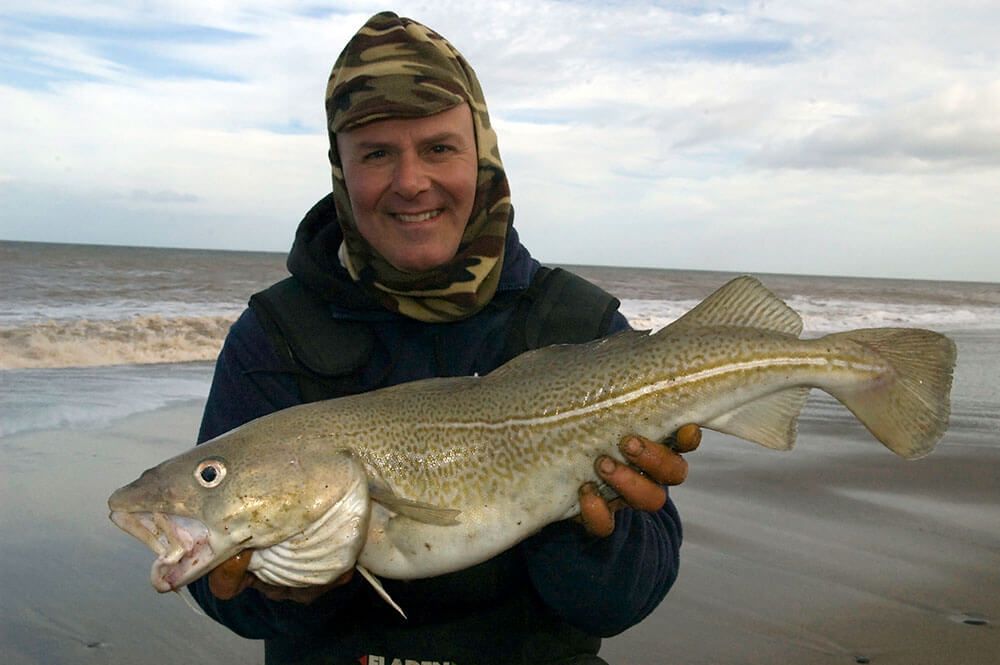
Cod can only really be confused with the whiting. The cod has a more blunt, bigger head, but the whiting's head is more pointed towards the jaws. The cod's lateral line is more pronounced and features an upwards curve above the pectoral fin. Also look for a definite black or dark spot positioned at the root of the pectoral fin on the whiting, which is missing on the cod.
When living over sand cod take on a mottled fawn or light brown colouring on the back with a white underside. But when feeding mostly over mixed rougher ground and broken shell they become slightly greener on the back for better camouflage.
They achieve sexual maturity at the age of four and female cod can produce up to 10 million eggs. The fry are rarely evident, but by the end of their second spring can be found close inshore and will range from four inches to seven inches in length. Overall growth is rapid and by their third year they should weigh in the region of 4lbs, though are still not fully mature.
Cod spawn between February and April is depths of 200-meters plus. A large adult female can lay between four and six million eggs in one spawning. The eggs are transported on ocean currents to maximise the range of distribution.
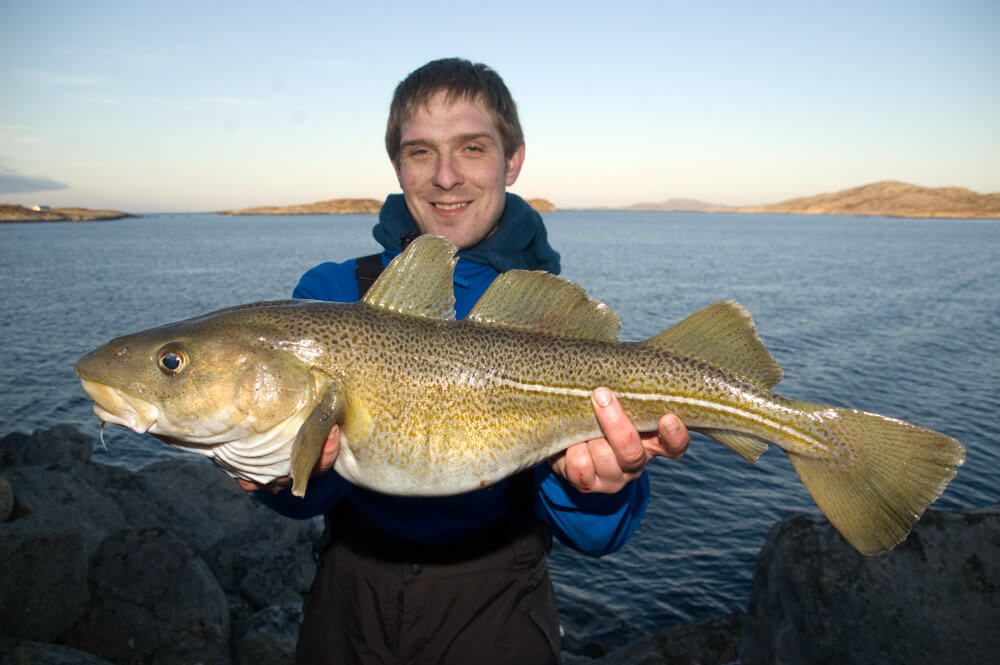
The Atlantic cod is commonly found along the northern half of the east coast of America down as far south as Maine. Along the coast of Newfoundland, Canada, around the southern half of Greenland, all around Iceland and throughout Norway as far as the Barents Sea off Russia and as far north as The Arctic.
Cod are found all around the UK with heavy concentrations in the North Sea, English Channel, Irish Sea, and off Scotland as far north as The Faroes. They are also common throughout Ireland but with the north-western coast from Mayo through Donegal and Northern Ireland tending to have the greater number of fish.
Cod are a versatile fish being found off the shore in just a few feet of water right down to the edge of the Continental Shelf in depths of 2000-feet or 600-metres.
Inshore they are found on shallow and steep-to beaches over sand, inside small and major estuaries, and off rocky cliffs and scars over rough ground. Offshore they like rough ground in deeper water, especially reefs, also wrecks, but can also be found over cleaner more broken ground.
Cod are designed with a large mouth in comparison to the body for hoovering up food items off the seabed and sucking in the baitfish that they prey on. A typical cod diet includes crabs, worms, shellfish, shrimps, and squat lobsters, but as they grow bigger and start taking live fish, they add poor cod, pouting, whiting, flatfish, sandeel, herring, and mackerel. They are also cannibalistic and will happily eat their own kind.
Season
In Scotland and the Northeast of England cod can be caught pretty much throughout the whole year, though from September onwards numbers increase as more fish move in from deeper water.
In the south of the UK, the traditional start to the cod season is again September with the first fish generally showing from the shore marks in the upper Bristol Channel, from Dungeness Beach in Kent, and Chesil Beach in Dorset, The Tamar Estuary, and from the East Anglian, Lincolnshire and Yorkshire beaches.
In the west of the UK the season is much the same with September seeing the early vanguard of fish.
In all areas, numbers increase throughout October, with the peak period for shore cod being November through to Christmas. Come late January, cod numbers rapidly thin out as the fish move offshore prior to spawning.
In some areas, especially the East Coast of England and inside the Severn Estuary being examples, there can be what is called a spring run. This is a migration of smaller codling under 5lbs that come back inshore to feed during the late March to early May period. This is likely to coincide with the springs first real flush of peeling crab during the bigger spring tides of these months.
Tides
Cod like real movement in the tide indicating that it's the bigger spring tides that will provide the very best fishing. The prime tides are those that fall three days before the biggest spring tides. Once the spring tides reach their peak height of that cycle, the fishing will normally slow.
Ebb tides generally are less consistent, but on the deeper steep-to beaches where there is more depth, the ebb tides can still produce fish, though at lower levels than the bigger tides will.
On shallow surf beaches low water and right through the flood tide to high water can be a good time, but once the ebb starts typically the fish move further out, often beyond fishing range. On deeper Steep-to beaches, often the cod come in with mid-flood when the tide picks up speed, staying until high water, but it will vary from beach to beach.
When fishing a shallow surf beach that has a rough ground or reef around the low water mark then fishing the middle ebb, if you can cast to the rougher ground, can often produce good fishing.
Weather patterns
Cod like rough seas with a good swell and a surf running. This displaces food from the sand and the cod move in to feed. Big Atlantic low pressure weather systems that bring gale force winds in from the southwest and west are the ones to watch for. As these produce surf and swell as they approach this can fish well, but the best fishing is after the gale blows through and the wind drops but the sea remains rough. Big catches can be made in these conditions.
Cod can be caught by day if the water is very coloured and ideally over 15-feet in depth to minimise light passing through the water column. But experienced cod anglers will always fish at night, as this is when the bulk of the fish move inshore to feed.
Habitat
On shallow beaches, look for specific stand out ground features. Deeper sand gullies running parallel with the shore trap food pushed in by the tide and will hold cod. Note any areas where patches of shingle, broken boulders or mussel beds lay as these will hold food and the cod will visit. Junctions of boulders and sand are good, also channels between sandbanks where the fish will pass through as the tide floods in. All these are cod hotspots.
Also target any bigger areas of rough ground, especially where there are a mix of smaller and bigger boulders.
Take the time to study the surf pattern on deeper beaches. Any areas where the surf breaks closer in indicates deeper water and are well worth fishing. Also look for areas where flotsam and jetsam, bits of wood and man-made rubbish, washes up on the shingle above the sand line as these identify a tide current that washes ashore here and will bring food with it. Also, any out jutting rock or shingle banks that defect the tide will again draw cod in to feed. Especially good are areas where there are deeper depressions as these will trap and hold food as the tide flows over them.
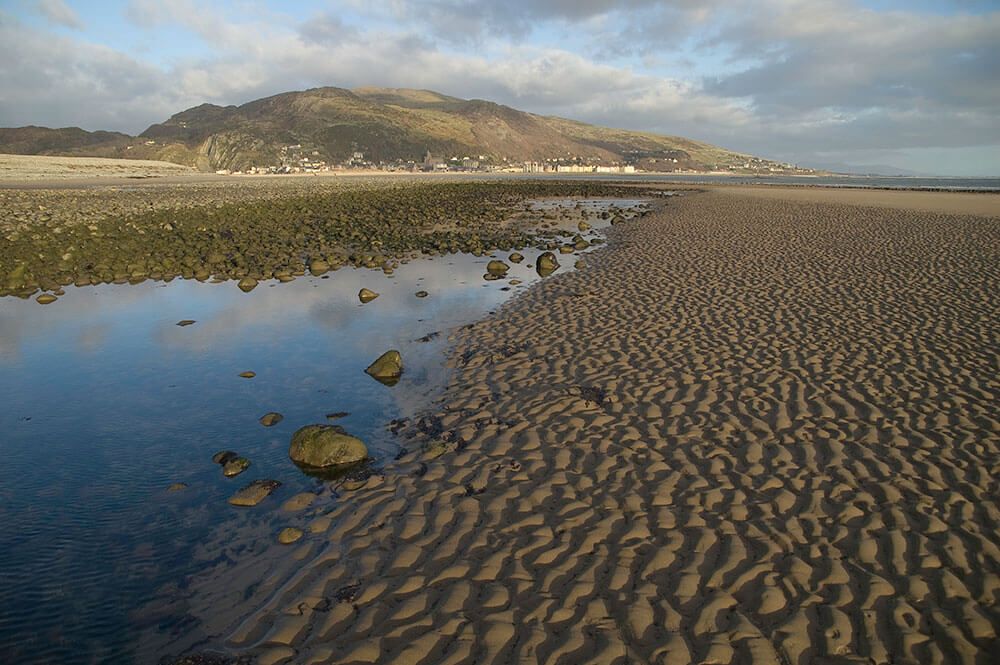
Tackle
Two outfits cover all surf fishing eventualities. The first, for general surf fishing, is a 14ft European style rod rated to cast up to 6ozs. For rougher seas a rod rated up to 8ozs gives added power and the ability to cast very big baits. This teams up with a 7500 sized fixed spool reel. A good choice is one with a modern "long spool' designed for braided line. An example is the Penn Spinfisher 7500LC. Load this with 30lb braid and add an 80lb braid shock leader. This outfit will maximise your casting range even with simple overhead casting styles and distance can often be critical when it comes to reaching surf cod.
If you use a multiplier reel, then look at a powerful fast taper, 5 to 6oz beachcaster between 12ft and 14ft. Most anglers opt for a rod between 12ft 6ins and 13ft 6ins. Over clean sand popular reels to go with this rod for maximum casting distance, which again can be a major advantage on many cod beaches, are the Abu 6500i TSR and the Daiwa 7HT series loaded with 15lb line and a 60lb shock leader, also look at similar sized reels from Akios. For rough seas and when fishing in amongst broken ground, most anglers prefer the increased winching power of the Penn 525Mag3, Daiwa SLOSH or the Penn Fathom Casting Special or modified casting versions of the original Fathom reel and loaded with 20lb line and an 60lb mono shock leader.
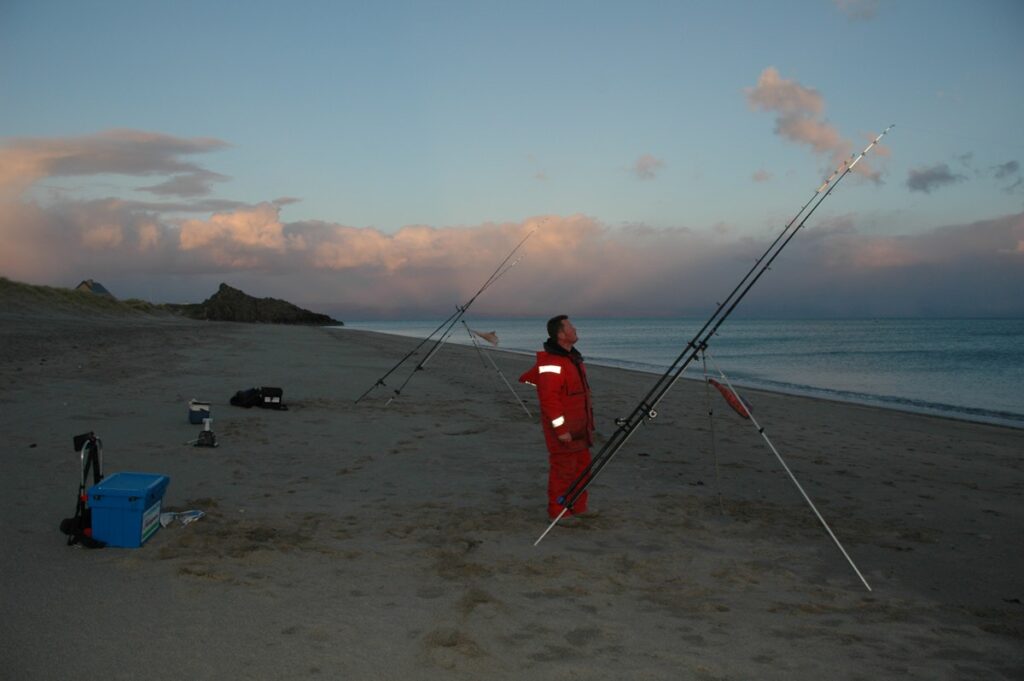
Clipped down pennel pulley cod rig
The clipped down pulley rig, over the past 20-years or so, has established itself as THE most efficient cod rig for surf and rough ground cod fishing. Really, you don't need to consider any other rig for normal situations and conditions. Here's how to build it.
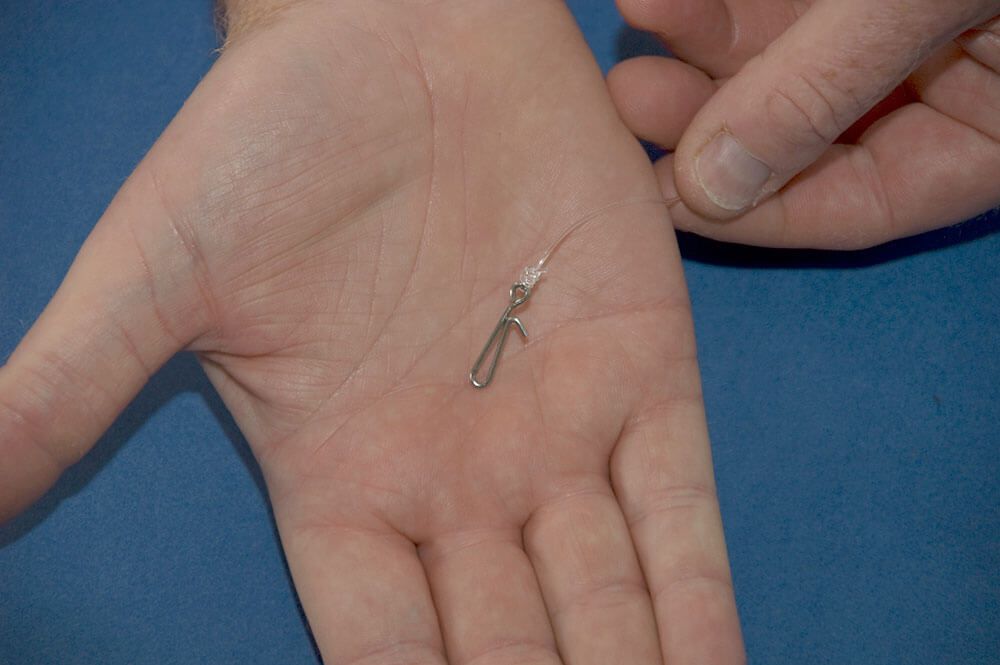
1. Begin with a 44-inch length of 60lb mono line. Tie on a Gemini lead clip link at the base.
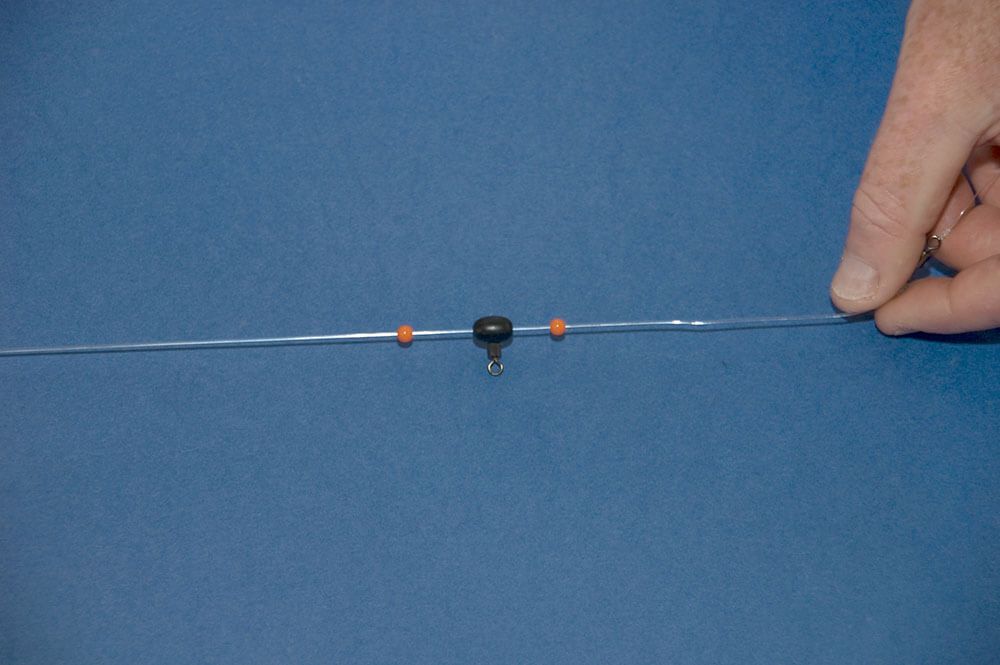
2. Slide on a 5mm bead, a size 4 rolling swivel, or better still a Pulley Rig Bead, and another 5mm bead.
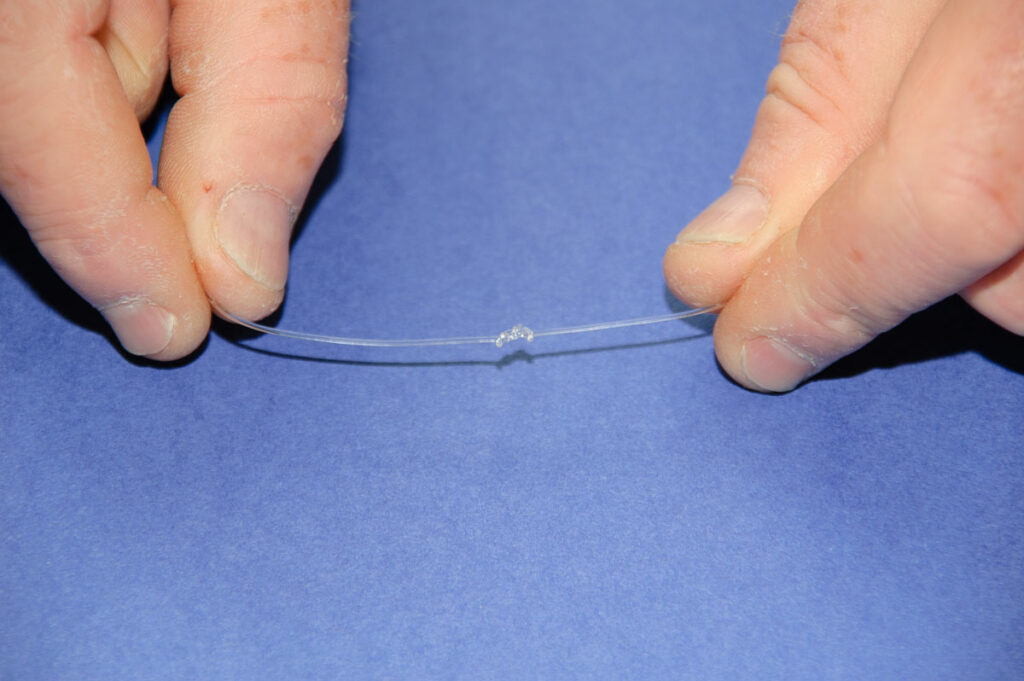
3. Below the last bead, tie in a figure-of-eight knot to form a 20-inch hook length.
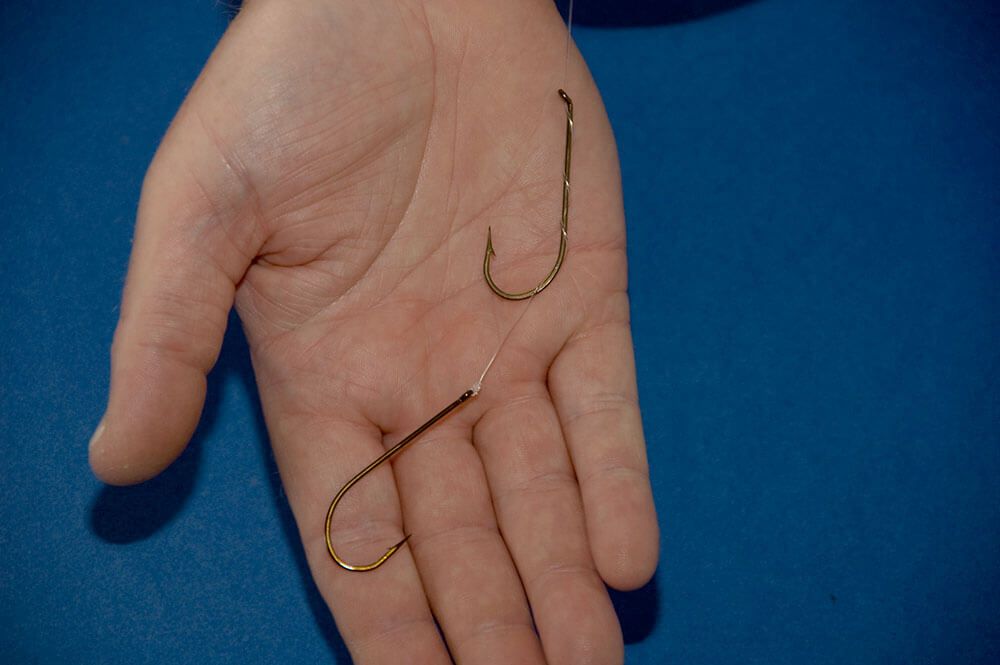
4. The two-hook Pennel rig uses a Mustad Viking 79510 top hook, and a Viking 79515 lower hook, both size 4/0’s. Slide the top hook on to the hook length via the eye. Now tie on the bottom hook. To secure the top hook after baiting up, position the hook about an inch above the bait, wrap the hook length around the shank of the top hook three times and pass the hook point in through the top of the bait for perfect presentation.
5. For casting, put the bottom hook in the clip of the lead clip link to tension the hook trace. The hook will fall free of the clip when the lead weight hits the sea's surface.
The TSF team likes to make this rig with 60lb mono all the way through. This adds strength to bully fish, helps to limit tangles when fishing heavy surf tables, and the heavier diameter 60lb mono combats the needle like teeth of the cod to limit abrasion.
This rig needs to be fished with a release wire lead weight, this to anchor the bait down in the heavy surf and make the bait an easy to attack target for the hunting cod. Leads with a long wire tail rather than a single short eye loop will hold better acting much more like an anchor in seas that are churning up the seabed. It is always worth carrying a few of these leads. They are also more stable in flight and fly like a dart preserving bait presentation when using bigger lugworm baits.
Also make sure that the hooks are always sharp and resharpen if necessary. Cod will hit the bait on the run and lift the lead weight out of the sand. This can be enough to set the hook themselves providing the hooks are sharp.
Baits
Black and blow lug are the top boats for cod in the surf. In the case of black lug, if they are fresh, nip the sandy tail off then thread them on to the hook tail first pushing the worm right around the bend of the hook and up the hook shank and only the mono between the two hooks of the Pennel rig. One big worm may be enough, but if in doubt, use two worms. The worms will normally burst so compress the worm or worms down the hook aiming to get a bait about 5 to 8-inches long and then bind it with a little bait elastic to make it secure for casting.
You can use blow lug in the same way pushing several onto the hook, round the bend and up the shank to create that bigger bait. You can also combine a main black lug bait with one or two blow lug at the hook point to put the main scent right at the point to attract the cod to take the bait at that end.
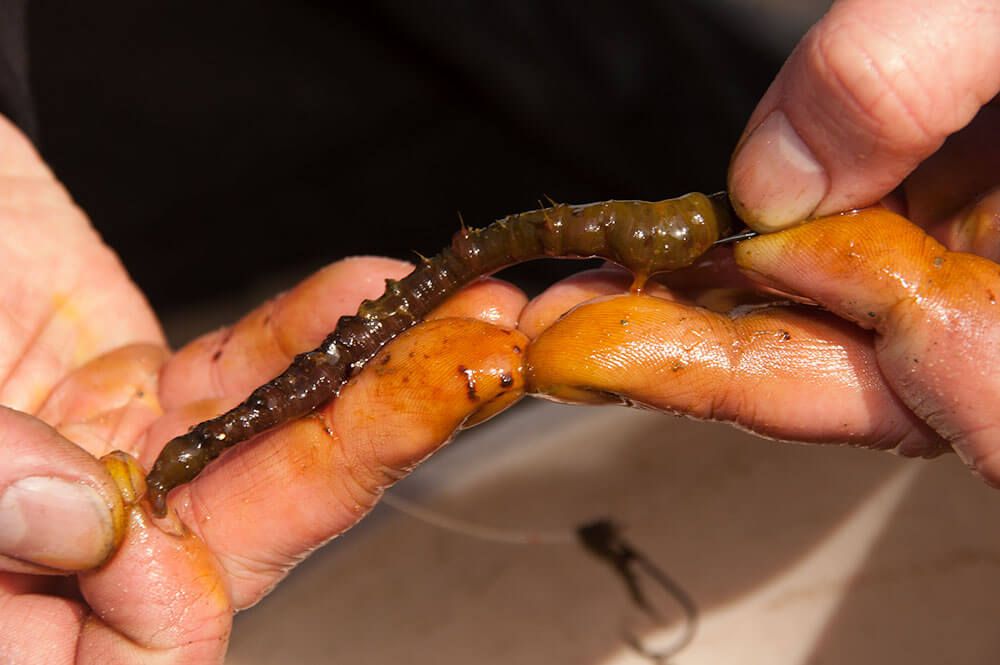
King ragworm is another good worm bait, but it works better when it's combined with black lug. In many areas, king rag is less effective as a standalone bait for cod. Presentation is again the same as for black and blow lug.
Squid can be used whole for cod but is better cut as a strip that is used as a splint down the length of the lugworm or added as a short three inch strip at the hook point. If you use it whole, then pass the lower hook of the Pennel rig down through the lower half of the squid and push the top hook in at the top. Bend the squid head back on itself so that it sits under the body, then bind the whole lot securely together with bait elastic. One whole squid is enough for surf fishing.
If you're fishing near rocks or patches of boulders, and even over clean sand, mussels can be excellent. The way to prepare mussels ideally, is to skeen (take out) the mussel flesh from the shell and drop them into a jar or sealable plastic container a good 24-hours before you fish. The mussel will then steep in its own juices and becomes more effective than when fresh out of the shell. Using three or four mussels, depending on overall size, push them up the hook to form a sausage shape about three to four inches long, then bind with bait elastic. A splint of squid down one side can add some stiffness and added security to this soft bait, alternatively, a length of black lug. Keep the lower hook point clear of the mussel and push the top hook in at the top of the bait.
Peeler crab can be excellent throughout the year both when fresh, especially in the spring, but also fresh or frozen during the winter run. The best way to present peeler crab is to take a whole crab, peel all the legs and the soft shell off it, cut the soft body in half lengthways across the body, then slide both pieces onto the hook. Again, it's a sausage shape you are looking for with a length about three to four inches, then bind with bait elastic.
Other shellfish, such as razorfish and queen cockle, can be killer baits to tip the worm off with just after a storm has passed through. These get naturally washed out of the sand by the pounding surf and the fish will be hunting for these.
In our experience, fish baits generally, such as mackerel, herring are a virtual waste of time for surf cod. In some areas, sandeel can take fish, but it is far less reliable than worm and shellfish baits.
Technique
The first step to successful cod fishing is to find those features on the beach at low water on a big spring tide when the water goes further out. Use shoreline or backdrop ground features such as sand dunes, trees, or a house, to get a bearing where the feature is from where you will cast. Getting baits into depressions, gutters or close to hard patches will make a huge difference to your catch.
Fishing two rods, if conditions allow, means you can target two different areas at different casting distances, say a gutter and a patch of rocks. Also, having two identical rods fishing side by side means you can compare the two regards bite detection, especially if you get a slack line or drop back bite and miss seeing it, which with cod, can often be the case. Two identical rod tips act the same, so a different response on one rod tip compared to the other suggests action is needed.
Cod also tend to come through in waves, especially the smaller fish. Having the two baits fishing means even when landing a fish or re-baiting, you still have one bait in the water to fully capitalise on potential bites.
When casting into a strong headwind use the biggest lead weight you can comfortably cast. A 6oz weight will penetrate through a strong oncoming wind better than a 5oz, and a 7oz better than a 6oz. This is due to the momentum and mass of the lead retaining power longer, therefore travelling further to increase your casting range. Heavier grip leads also hold better in rough seas and anchor the bait where the cod can find it. You can also get release wire leads to hold better by wrapping an elastic band around them for added grip.
Another good tip is to use brightly coloured shock leaders at night. These are easily seen and picked up in your headlight beam and will indicate exactly where a fish is in the surf tables prior to landing. It also gives the man landing the fish something to hold and then slide the fish ashore with until he can grab it by the gills.
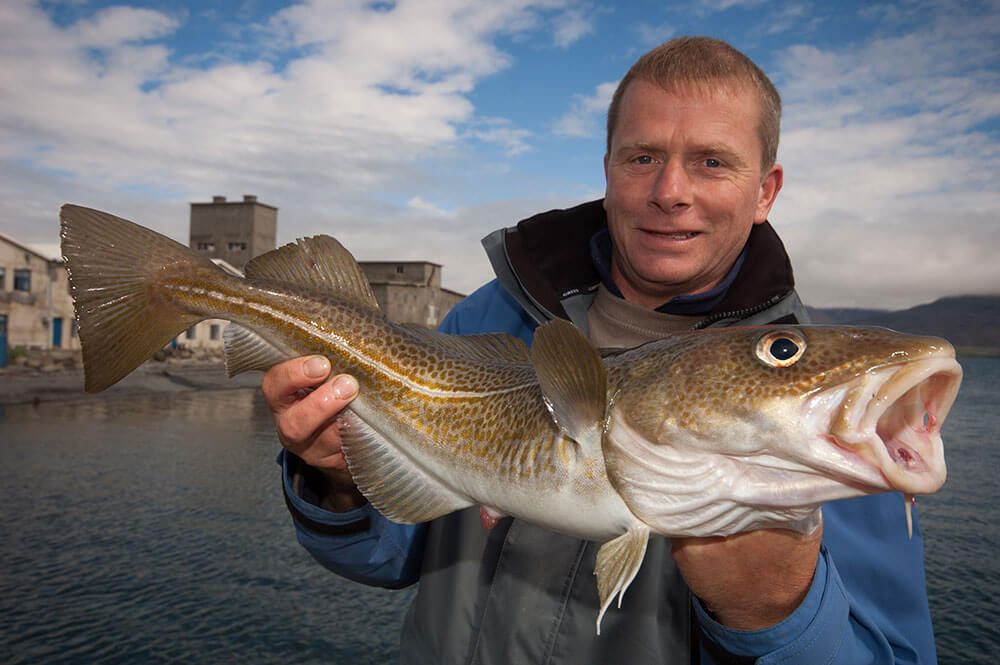
In water not too coloured, adding a couple of luminous green beads charged under your headlight, camera flash or dedicated UV Light, will draw cod towards your bait and will increase catches. Use small beads no more than 4mm in diameter and make sure they are highly luminous for maximum effect.
Cod bites are mostly dramatic, the rod tip may knock a couple of times as the fish takes the bait in, but then as it moves away and pulls the lead weight out, the rod tip will pull hard down, thump a couple of times, then spring back straight. These fish are mostly already hooked, but it's wise to quickly wind in any slack line until you feel the weight of the fish, then lift the rod tip to fully set the hook.
Bigger cod will thump the rod tip and shake their heads, but usually stay heavy on the rod tip until they feel the shallowing water then will make short runs parallel with the beach. They prefer to run with the tide and can take some line, but they will quickly tire. Look for the leader in the edge of the surf and for the flash of water as the cod twists and turns in the shallow water. Keep the line tension tight, wait for a wave to push inshore and let the wave wash the fish on to dry sand. If you bully fish and try and slide them in with the rod, then that is when a light hook hold can pop.
Surf fishing for cod top tips
[*]Getting to a beach just as a gale and rough sea is dying away and prior to low water can often reveal scoured out shellfish laying on the sand. These include razorfish, queen cockle, scallop, and sand clams. Tipping lug and ragworm baits with these can again increase your catch as this is exactly what the cod have moved into the surf to feed on.[*]Don't leave baits longer than about 15-minutes. Worm and shellfish baits will wash out quickly and cod, at night and in dirty coloured water, are hunting mostly by scent, so keep the baits fresh by re-baiting regularly.[/list]
The knack to finding the bigger fish will generally be to fish the rough ground and the heavier seas. If you're frightened of losing a lot of tackle, then rough ground cod fishing maybe isn't for you.
There are generally two types of rough ground. One type is an open beach with a seabed of boulders or rocky fingers in relatively shallow water. These occur in many areas and are prime cod ground. The cod usually run these beaches from low water up to high water, then move out. The two hours after low water and the hour either side of high water often tends to be best. Surprisingly, the middle hours of the tide on many beaches do not fish that well in comparison.
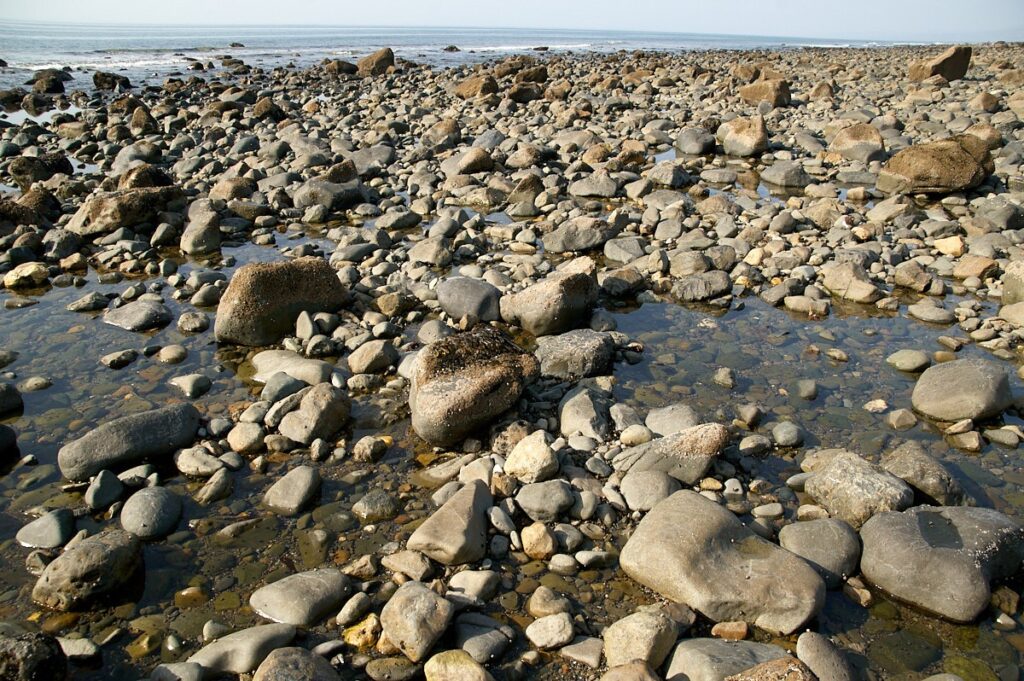
On these shallower beaches the bigger spring tides invariably fish best as the increase in tidal speed scours out the ground and exposes more food. The best time to fish these beaches is immediately after a good storm when the surf remains high, but the wind has dropped. This big sea further scours out any sand sitting between the stone and rock and washes out food such as worms and shellfish, plus it smashes mussels free from the rocks.
Because of the shallow nature of these beaches, it pays to fish only at night. Even when the water is well coloured after a storm, most fish will stay out in deeper water during daylight.
Try to look at the beach over low water. Pick out any obvious gullies or gutters that cut in towards the shore with slightly deeper water. These will catch and hold food washed along by the tide, plus are natural motorways for the fish to work through. Also identify scooped out areas around bigger boulders, small sections of shallow reef running inshore and any large rock pools, as once flooded by the tide, these will all concentrate food and fish.
On these shallow beaches, a long cast may be necessary to find the fish, especially over low water, but it's far more important to have your bait in, or tight to the described fish holding features. It's often the case that the cod are close in as the tide starts to flood, but move further out during the peak tidal flow, so adjust your casting as necessary.
Rock ledge and scar fishing
The second type of ground tends to be casting from rock ledges, rock platforms or rock scars into deeper, much rougher ground made up of rock gullies filled with kelp weed and covered in barnacles. This ground is typical along the Northeast coast of England, some parts of east and west Scotland, also areas such as Anglesey and Cornwall.
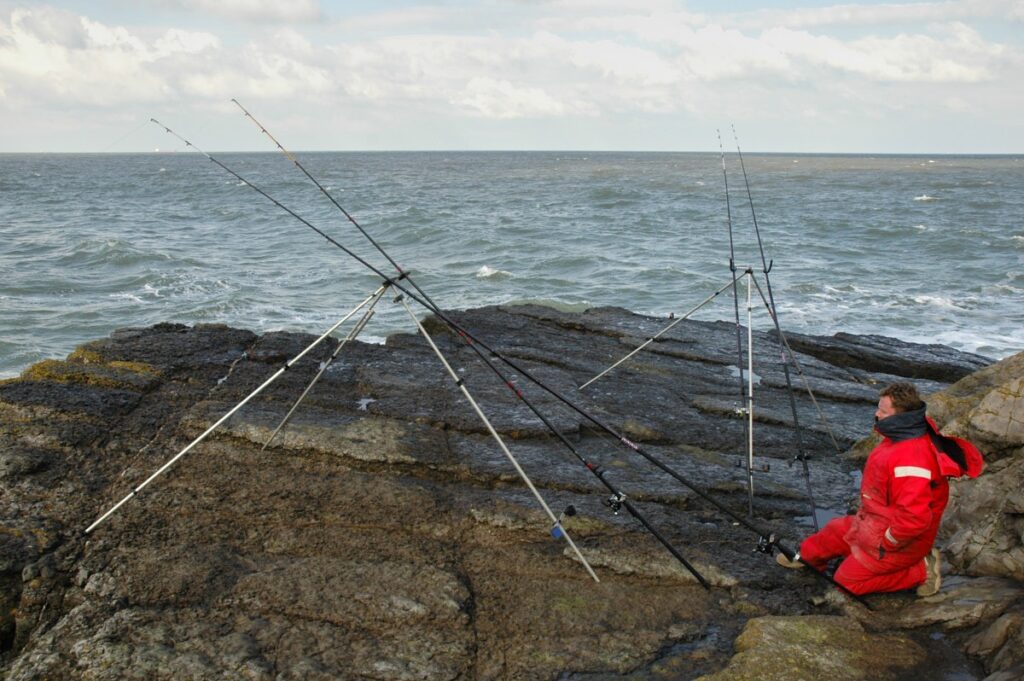
The gullies can be narrow and just a few feet across, or much wider with depths again from just a few feet to maybe 20-feet deep or more. They often have kelp and other weed growth evident, with rock covered in barnacles and mussels. These gullies are full of natural food including small fish such as shannies and blennies, crabs, and mussels.
The deeper gullies will fish in daylight as the fish have more cover, and especially if there is some colour in the sea, but again night-time generally is best for the more consistent catches.
Safety needs to be considered, but as before rougher sea conditions with a good swell tend to bring the fish in to the gullies. A good onshore wind is essential for the winter fish, though red summer rock cod can be caught in calmer conditions in a good depth of water.
This type of ground requires accurate casting, aiming to put the baits directly into the gutters where the fish are. Sometimes you'll take fish at just 20-yards range, though most casting will require accurate casting up to 70-yards. Good anglers, experienced over this type of ground, will fish at much longer range as appropriate to pick out their favoured gullies.
Tackle
In both cases, rough ground beaches and when fishing from rock ledges and scars, this can be brutal fishing, so a powerful, very fast taper blank rated to cast 6ozs is necessary. Length can be 13 to 14-feet, but make sure the rod is stiff to literally bully and drag fish over and out through snags. The extra length of rods of 13ft or more helps give you more steerage of hooked fish and keeps the rod tip up and out when the fish are close in ready for landing.
For the shallower beach a Penn 525Mag4 is a very popular reel as it has the tough gears and build quality required, but equally can hit long range. Main lines from 18 to 25lbs are typical, depending on casting range needed, with a 60lb shock leader.
For the very rough ground some Shimano and Avet reels have a larger line capacity. Load these with 25 to 30lb line main. For short range casting there is no need for a leader with the 30lb line, but for long range work you will still need a 60lb shock leader.
Some anglers are also using the longer 14ft to 15ft European rods, especially those rated to cast 200g. These are matched to a 7500 or 8000 sized reel and loaded with 60lb to 80lb braid line. The longer rod gives greater reach and leverage against a fish and the heavier 60lb plus main line obviously allows you to really bully a fish through the kelp and snags.
Rough ground cod fishing rig
Because we're fishing in very rough ground, we need to beef up the rig for added strength and abrasion resistance.
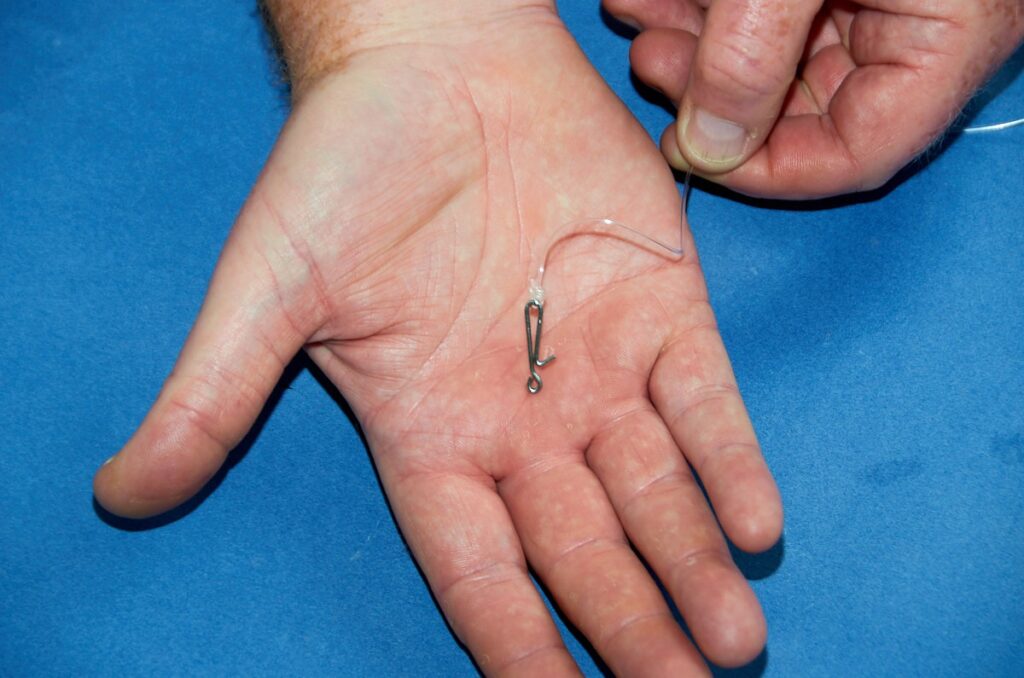
1. Begin with a 44-inch length of 80lb Rig Body line. Tie on an inverted (upside down) Gemini bait clip link at the base.
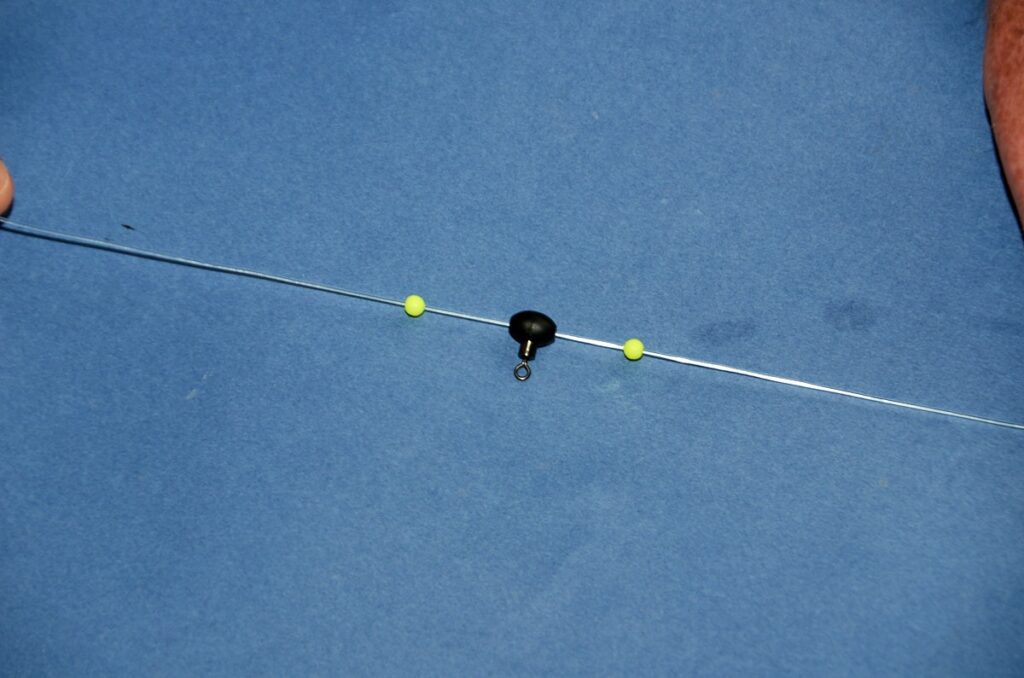
2. Slide on a 5mm bead, a Pulley Rig Bead, and another 5mm bead.
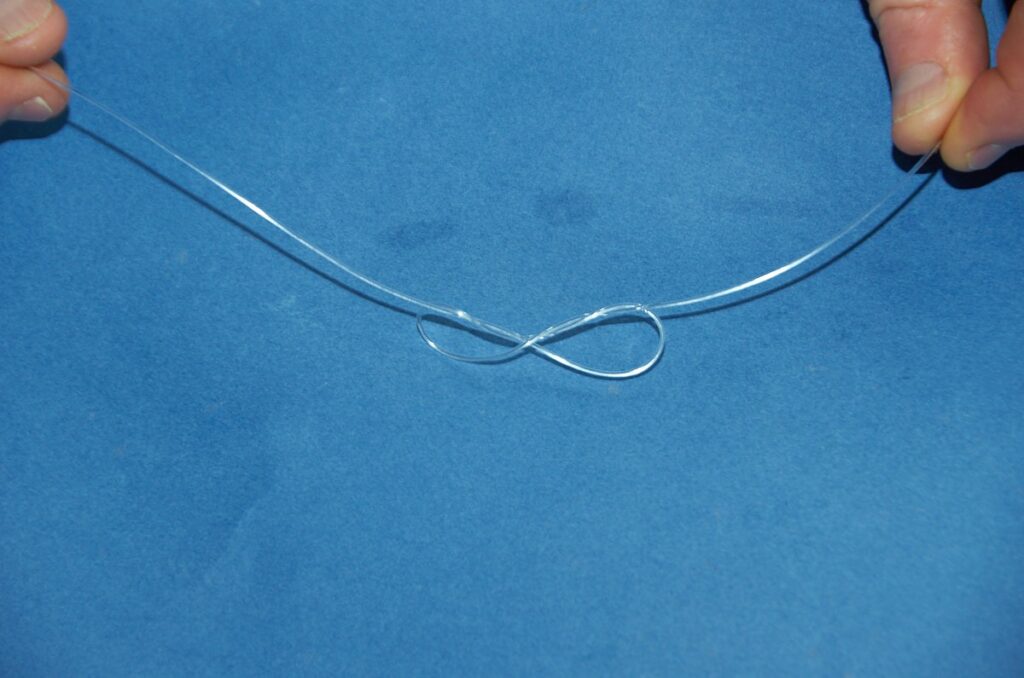
3. Below the last bead, tie in a figure-of-eight knot to form a 20-inch hook length.
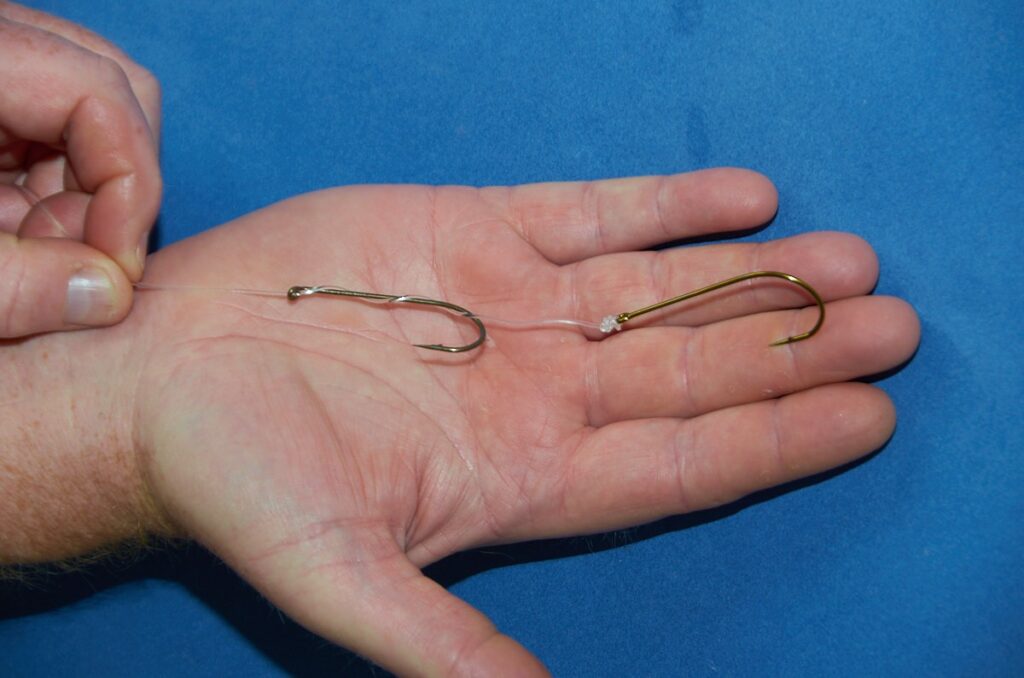
4. The two-hook Pennel rig uses a Mustad Viking 79510 top hook, and a Viking 79515 lower hook, both size 4/0's. Slide the top hook on to the hook length via the eye. Now tie on the bottom hook. To secure the top hook after baiting up, position the hook about an inch above the bait, wrap the hook length around the shank of the top hook three times and pass the hook point in through the top of the bait for perfect presentation.
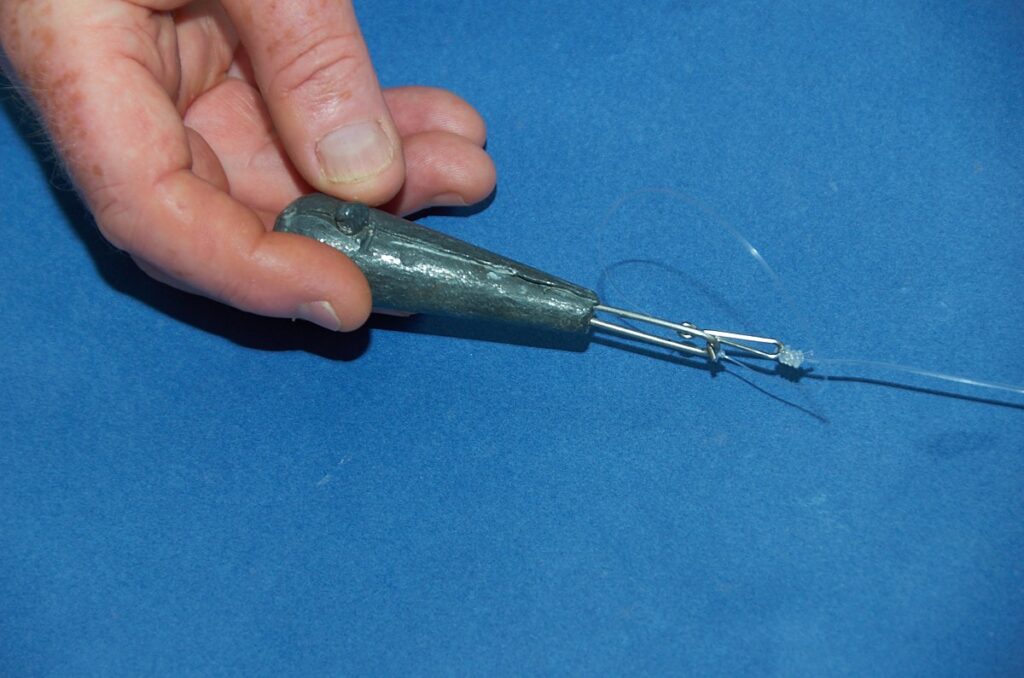
5. When fishing rougher ground, tie a short section of weaker 20lb line to the eye of the inverted Gemini clip link, then tie the free end to the eye of a lead. The eye of the lead then sits on the actual bent wire clip of the inverted Gemini clip for casting. The lead will fall free of the bent clip when the lead weight hits the sea. The 20lb weak link will snap relatively easily meaning you only lose a weight and not a fish or whole rig.
Alternatively, if you need to clip a bait down, then instead of adding a clip directly on the rig, tie on a Gemini bait clip as normal, then add an upside down one into this. For casting, put the bottom hook in the clip of the lead clip link as normal, tie on a weak link of line between the eye of this link and the eye of the lead, then place the eye of the lead in the clip on the upside down clip link. The hook will fall free of the clip when the lead weight hits the sea's surface.
Rough ground cod baits
Over both types of ground big lug baits up to 8-inches long work well or mix both rag and lug as a combination. You can tip this off with a strip of squid, or a full razorfish bound along the length of the lugworm, the latter improving the security of the softer worm bait for longer range casting.
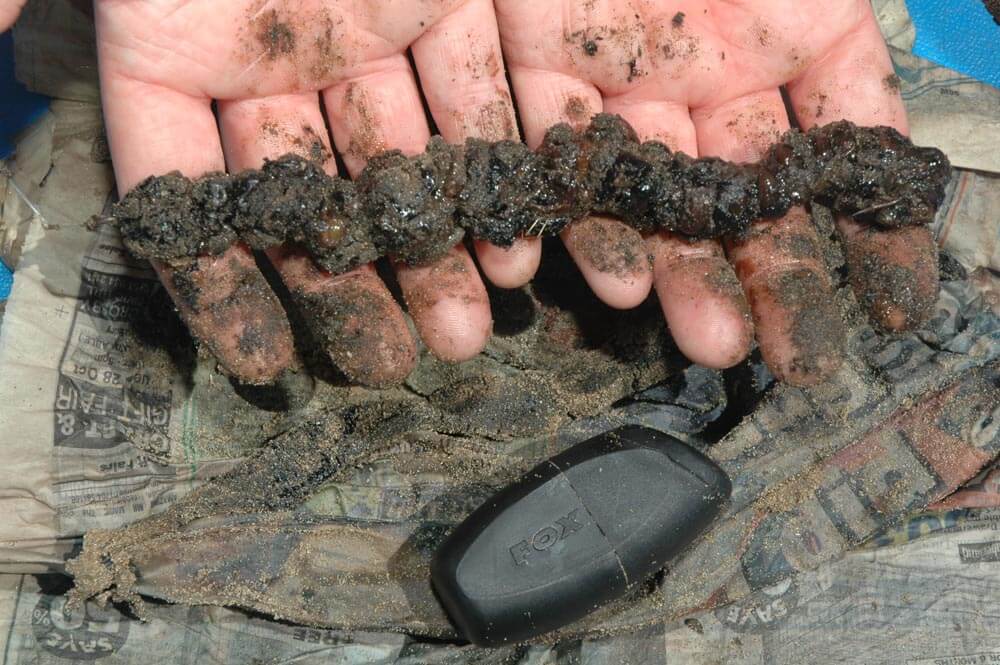
Other good baits are several big mussels bound onto the hook into a sausage shape. Use enough bait elastic to fully secure the mussel otherwise it will fly off during the cast.
Peeler crab is good bait, both fresh and frozen and will catch throughout the year but is best in the autumn and spring. Take the legs off a dead peeler crab, peel all the shell off the crab body, then cut this into two halves. Push both sections of crab up the bend and hook shank then bind with bait elastic to secure the bait. This will leak lots of scent but in this rough sausage bait presents the hook point well clear of the bait for easy hooking.
Whole squid are also a good bait. Squid no longer six inches are ideal for shore fishing being easily taken in by average cod, but also small enough to cast well. Thread the bottom hook of a Pennel rig in through the top end of the squid and pass down the body to bring it out near the head of the bait. Put the top hook in through the top of the bait once to bring the hook point fully through. Bend the head of the squid back under the body then bind it together with bait elastic to fully secure the bait for casting.
Rough ground cod fishing tips
[*]Leads specially made with soft release grip wires that bend under pressure often snag less than plain bomb and normal grip wired leads. The wires help keep the leads out of the cracks that weights typically jam in. These also keep you anchored in the rough ground and will not roll around in any tide run either.[*]Some anglers prefer to use a big fixed spool reel and load with 50, even 60lb braid line to give greater lifting power, especially when fishing at short to medium range into very heavy snags. This requires no leader, plus gives excellent bite detection when holding the rod and feeling for bites.[*]It pays to have one rig fishing and another ready baited with a link attached to your leader for a quick change. Often a small group of cod will pass through over a short period giving you the chance of two fish if you have a ready baited rig available.[*]In semi coloured water, and when night fishing, adding a luminous yellow bead immediately above the hook can sometimes increase your catches. Make sure you charge the bead under your lamp or torch beam before casting.[/list]
Cod are resident on the inshore reefs and offshore wrecks for much of the year all around the UK, though tend to be smaller fish up to 7lbs during the summer and early autumn in many southern areas. In the north, off Yorkshire, the boats take good cod to 10lbs off the inshore grounds but are always in with the chance of a 20lb plus fish when fishing the wrecks during the summer. The inshore rough ground also provides excellent fishing through much of the winter here. Throughout Scotland the inshore cod run to 8lbs or so, with the occasional bigger fish throughout the year.
In the south, the bigger fish move inshore from September in areas such as the Thames Estuary and Bristol Channel, staying until January. But it's from January through to March that the big cod begin to move out on to the wrecks and gather for spawning. This is when the bigger fish over 20lbs and 30lbs are caught.
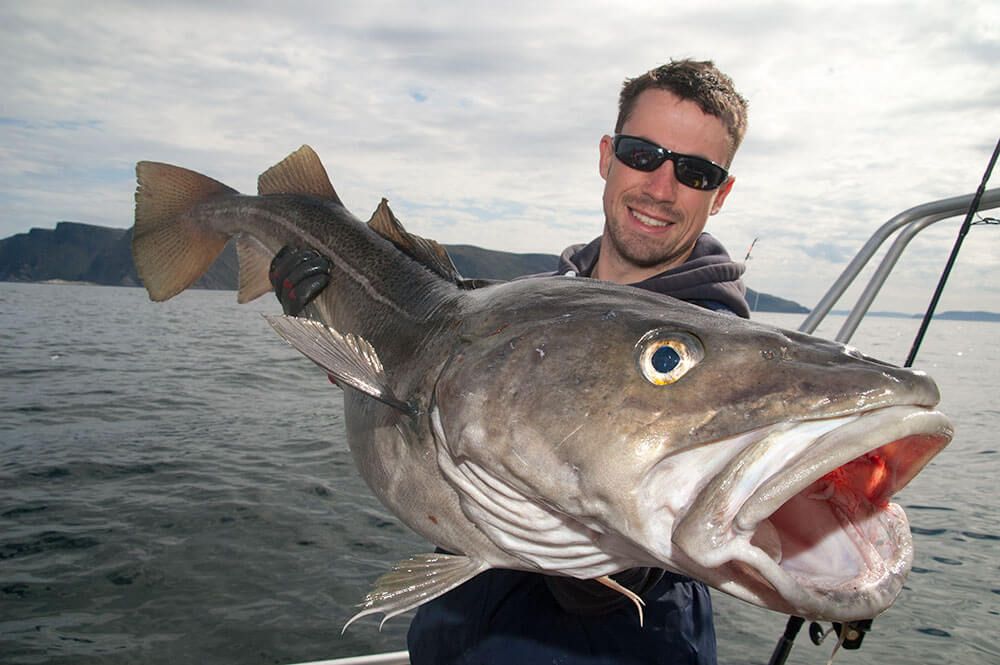
Although big cod will grub for food on the seabed, for the most part they are predatory eating small fish such as sandeel, pout, poor cod, rockling, whiting, small cod, flatfish, herring, mackerel, crabs, squat lobster, and any shellfish they come across.
In the winter, when the sprat move close inshore during calm settled weather, the cod can become preoccupied on these and move up off the seabed. Catching cod at this time can be difficult.
Uptide fishing is the most successful technique when anchoring in fast tides areas such as the Bristol Channel, Thames Estuary, and the Mersey Estuary, but can be utilised anywhere when the boat is anchored.
Uptiding means the angler casts the baited rig in a sharp uptide direction, then as the lead weight hits the seas surface, begin releasing line again until you feel the weight touch bottom. Release a further 20-yards or so of line, then click the reel in to gear. The release of line after the lead hits the seabed creates a big downtide bow in the line that sees the line bow below the rig and the weight pull the grip lead deep into the seabed and anchor the bait, much like a boat's anchor rope does. The rod tip now pulls steadily over into the tide.
Bites will register typically as a double knock, then a sharp pull down and the rod tip will spring back straight as the fish pulls the lead weight free. Lift the rod, wind down until you feel the weight of the fish, now lift the rod to strike and fully set the hook.
When casting uptide, try different casting distances and vary the angle you cast into the tide. In this way you can search the ground to try and identify small areas where bites are more numerous. Trust us, this is a common thing that certain small patches of ground will produce the most fish. It may just be a depression in the seabed, possibly just a heavier cluster of stone, but it's enough to see fish visit it.
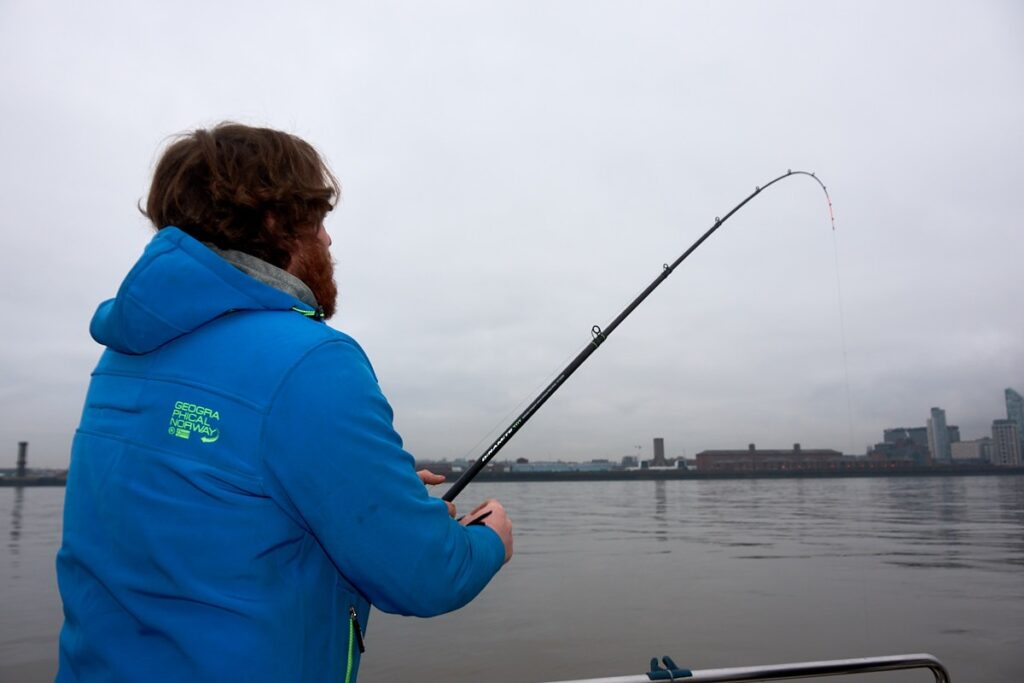
Uptide fishing tackle
Typical uptide rods for cod will be between 9'6" and 10' in length with a very supple tip, but powerful midsection and butt to give the casting power. Cod uptide rods are rated 4 to 10ozs or better still 6 to 10ozs.
Reels need to be able to cast to a good range but have powerful gears and frames. Popular reels are the Penn 525Mag4 loaded with 20lb line and a 60lb shock leader, though some prefer to use 25lb line and dispense with a shock leader as you are not power casting.
Some anglers prefer to use a big 8000 fixed spool reel loaded with 30/40lb braid and dispense with a shock leader. The extra winching power of the fixed spool, and its ease of casting, is well worth considering if you're new to uptide fishing.
Uptide casting rig
A simple and quick uptide rig that doesn't tangle can be tied as follows.
The lead weight is important as it dictates the effectiveness of the rig. There are two types of lead you can use for uptide fishing.
One is the standard release wire grip lead. This needs to have the wires where they come out of the lead body and before they turn the corner to rise above the lead to bend down so that they fit very tight in the grooves of the lead to increase the pressure needed to release them. You can add further grip by looping a rubber band over one of the legs, then wrap it around the legs and body to increase the pressure on the release wires. This works well if you release enough line to create a big bow and when you're fishing tides that are not overly powerful.
In areas where tides are faster and you need more grip, then change to a lead weight that has the wires permanently fixed in the nose of the lead. These are often called "Sputniks" because they look like the Russian space satellite launched in 1957 with its trailing antennae. It's the same principle, releasing enough line to create a big bow, then the wires in the nose react exactly like an anchor and dig in to keep the bait fishing effectively. The weight will lift off the seabed when the cod turns into the tide and swims away after taking the bait.
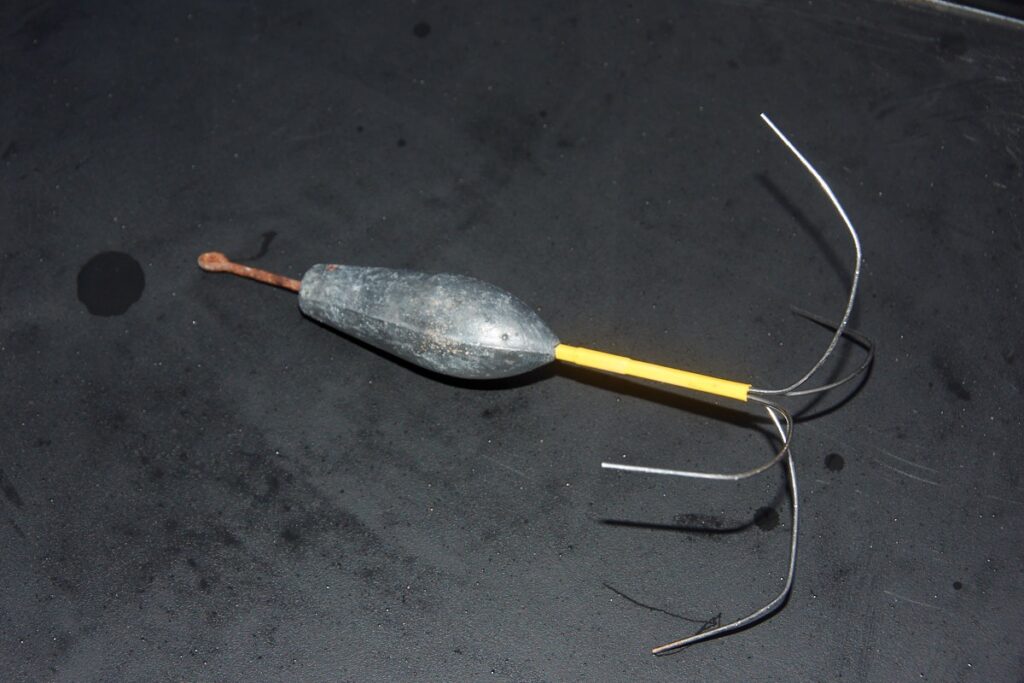
Baits
For uptide fishing big lugworm baits are excellent. Use one or two whole black lug depending on length, then add several smaller and juicer blow lug at the bottom for added scent. These need to be formed like a thick sausage shape, bound with elastic thread, and be from six to nine inches long. After each retrieve, leave the old bait on and add fresh to maximise scent and bait size. Adding strips of squid for movement, mixing ragworm with the lug, and tipping with crab, razorfish and mussel can also be highly effective.
To target much bigger cod try fishing whole big squid or cuttlefish, or two or three smaller squid.
Half and full sections of bluey, also whole mackerel cut as a flapper, and herring can work around wrecks and reef ground.
To create a flapper mackerel bait, hold the tail of the mackerel in the non-dominant hand, place the knife at the root of the tail and take the full fillet off the bone right up to the gill, and on both sides, then cut the backbone out at the head leaving the fillets attached to the head. Pass the hook through both jaws of the mackerel with the point facing upwards.
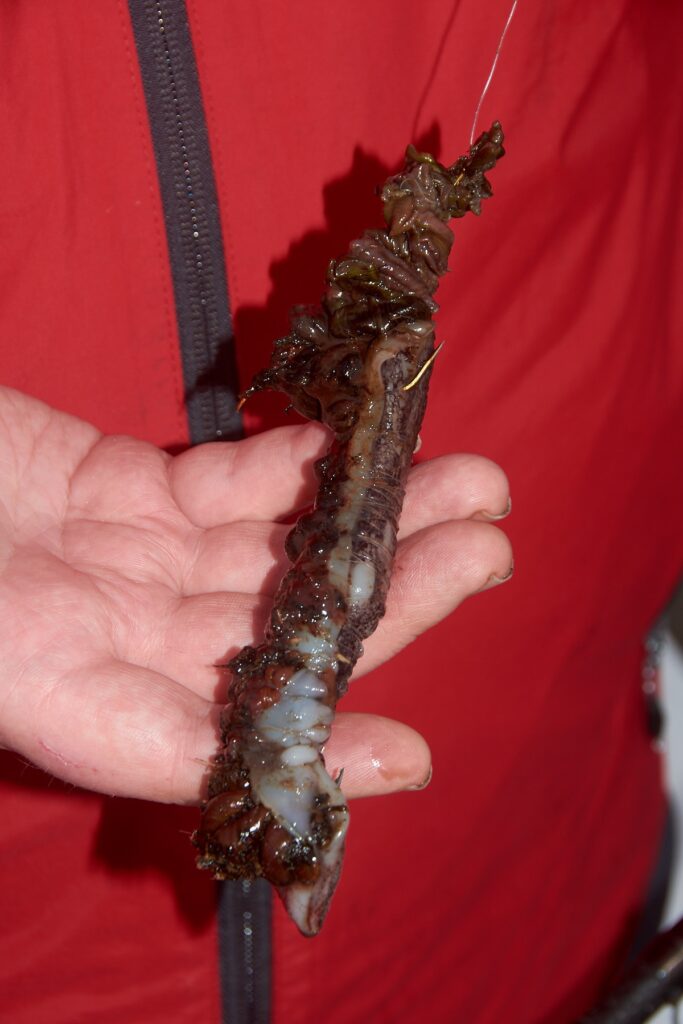
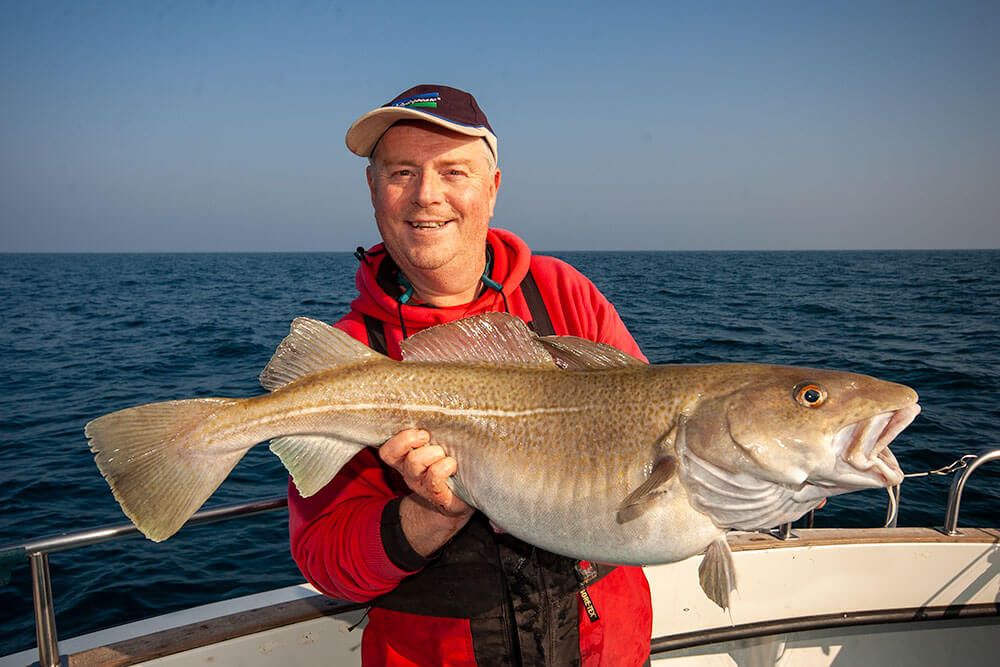
Pirk fishing
During the 1960's, boat anglers fishing the deep water wrecks, pretty much breaking new ground at the time, found that metal pirks up to 12-inches long proved very effective for catching big cod over 20lbs.
This was physically demanding fishing with the pirk having to be worked on the rod tip by lifting it up and down in the deep water to give the pirk movement. This is a method that still works today but is used far less in current times.
The pirks were made either from chrome car door handles, which were common on 60's and 70's cars or made from chrome tubing flattened at one end with a hammer, filled with lead, flattened at the other end, then holes drilled in the flat ends to take heavy duty split rings for hook and swivel connection. It must be said that chrome is very effective due to it reflecting any available light, but many anglers fished copper pipe filled with lead or any other pipe and even the darker colours caught fish pretty much just as effectively.
There are also many forms of pirks made commercially, some of the best being the Solvkroken ones that have a bend in their length allowing them to move erratically in the water when worked. These are proven in Norwegian and Icelandic waters and have taken some huge cod over the years.
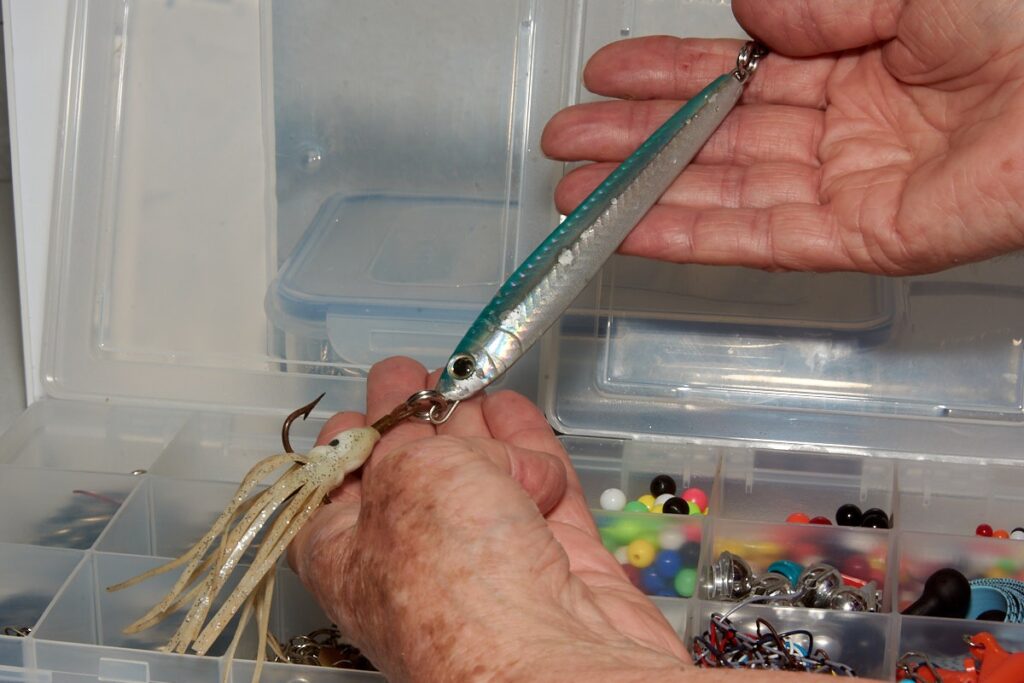
Tackle needs to be heavy. 30lb class rods with reels such as Penn Fathom 25's or 30's loaded with 50lb braid and a short 60lb fluorocarbon leader to separate the coloured braid from the lure and to add some abrasion resistance should the line immediately above the lure meet seabed debris or the wreck.
You can improve the effectiveness of pirks by adding either luminous green or pink tubing to the shank of the hook or add a pink or lumo green or yellow muppet to the hook shank, this to add both colour and more movement.
The major downside to pirk fishing is that fish are easily foul-hooked due to the constantly erratically moving pirk being hard to predict and hit for the attacking fish.
When working pirks, keep the pirk close to the seabed, typically around two or three feet above, but also try higher, especially at low water as the fish can move higher then as the tide slackens off.
Another trick when fishing a pirk, is to have a short 10-inch hook length of 40lb line with a small clip link on tied about four feet above the pirk. This is called a "flyer" and maybe the pirk imitates a predator about to attack a smaller bait fish. What it does is position a lure up off the seabed and this will take any cod that are swimming up off the bottom.
Killer gear rig
This is another very effective but somewhat old fashioned style of fishing. It can be fished either with a lead or with a pirk.
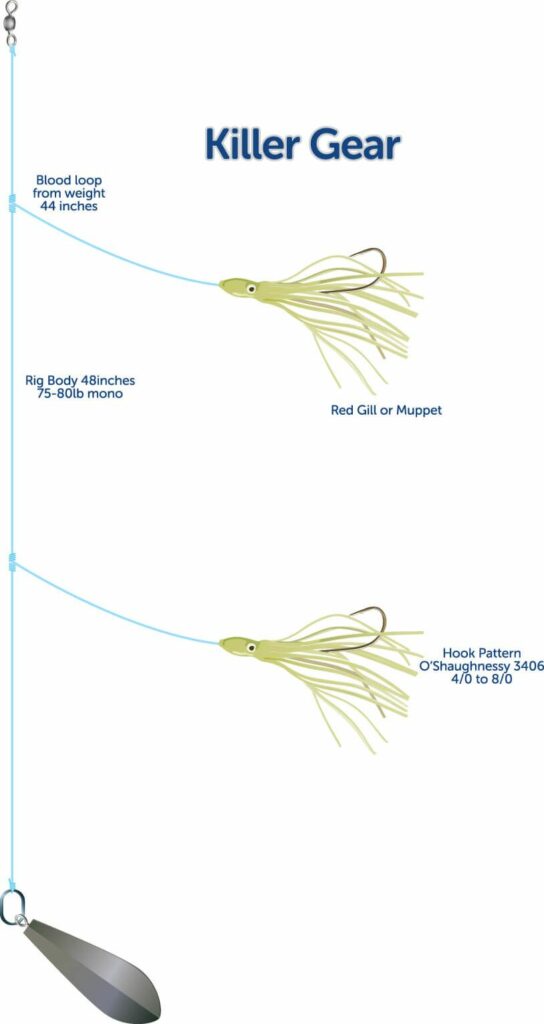
The rig is best fished on 30lb class tackle capable of landing two large fish at once.
It's important to use a lead weight heavy enough to keep the line fishing almost vertically. If the line is streaming off downtide because you're using a weight that is too light, then your chances of snagging the reef or wreck are much greater. Learn to adjust the weight of your lead to the boat speed and the flow of tide aiming to use just enough to keep in vertical contact with the seabed, but no more.
Fishing this rig is easy! Using a heavy weight to punch through the smaller fish, allow the rig to descent fast as it can't really tangle, touch bottom, then retrieve just two or three feet of line, then lift and lower the rod tip in a slow and methodical lift of the main arm to work the lures in an up and down sequence. This simulates small fish swimming in the water column.
A good tip is to change the weight for a chrome coloured pirk. This has the weight to power through the upper water column shoal fish, but presents a big, fluttering target when worked that adds vibration and attraction, and by itself can take big fish. You can also add another muppet to the hook on the pirk for more movement and attraction.
The colours you choose for the muppets can be critical to what you catch. Cod favour pink muppets, but will also take white, yellow, red, and black on the day, even luminous green ones. Of course, all colours work, but these named colours do tend to pick up a higher percentage of these individual fish. Also try mixing two colours on the same rig.
As for artificial eels, such as Redgills, Eddystone Eels and Power Worms, then black bodies with either a red tail or yellow tail, often called Firetails, work well, or all red or white bodies. Sidewinders are a great lure too, especially the Rhubarb and Custard colour.
The same applies to shads. The top fish takers are black, red, clear blue and white. Anything with sparkle in it also works. The Berkley Ripple Shads are a hot lure as they have ripples formed in the sides that add much more vibration and these also take a lot of fish in all sizes.
And remember you can ignore the lures and choose to fish just two baited hooks or add a long strip of mackerel to the hooks used on the muppets. This little dodge often increases the catching power of this rig on days when bites are difficult to come by. It's also ideal for drifting scattered wreckage over more open ground by just keeping the lead in touch with the seabed to fish the baits dragging tight to the bottom. This is often how the biggest ling and cod are caught.
To limit tackle loss, you can also tie to the oval split ring to a few inches of lighter line. This should be about 20lbs and will break off should the lead weight get caught in a snag. This simple trick can save otherwise lost fish and end tackle for the loss of a sacrificial lead weight.
Modern sport fishing trends now dictate that most anglers prefer to fish artificial lures for the wreck and reef dwelling cod. These range from artificial sandeels and jellyworms, weighted sandeel imitations such as the Berkley Powerbait Sandeels and Sidewinders, also soft shads such as the Berkley Ripple Shads fished on a lead head, and the weighted Storm and Savage Shads and sandeels.

Tackle
Tackle for working soft plastic or rubber lures, even in deep water, does not need to be overly strong. Over shallow reef ground in gentle tides an 8ft 12lb class rod with a reel such as the Penn Fathom 15 loaded with 20 to 30lb braid is perfect.
For deeper water and faster tides, a 12/20lb class rod, or possibly a 15lb class rod between 7ft 6in and 8ft with a supple tip but power in the mid-section and stiff butt is impossible to beat. Stick with the Penn Fathom 15 or a similar reel and load with 30lb line.
Occasionally, when working over ground in less than 80ft of water lighter tackle can be employed. This would be a 12lb class rod with one of the modern baitcaster multiplier reels loaded with 20lb braid. This is perfect for working weighted shads and sandeels and still has the power to beat big fish.
In all cases do add a shock leader of fluorocarbon in the same breaking strain as the main line you are using. This needs to be a little more than twice the length of the rod to allow a fish beaten on the surface to be drawn to the boat side with the shock leader already wound a few times onto the reel.
Lead shapes need to be streamlined, so go for torpedo shapes, bomb shapes or ball shaped weights. These fall through the water column cleanly without any tendency to veer off to one side. Leads with flat sides can sometimes be erratic in the way they fall.
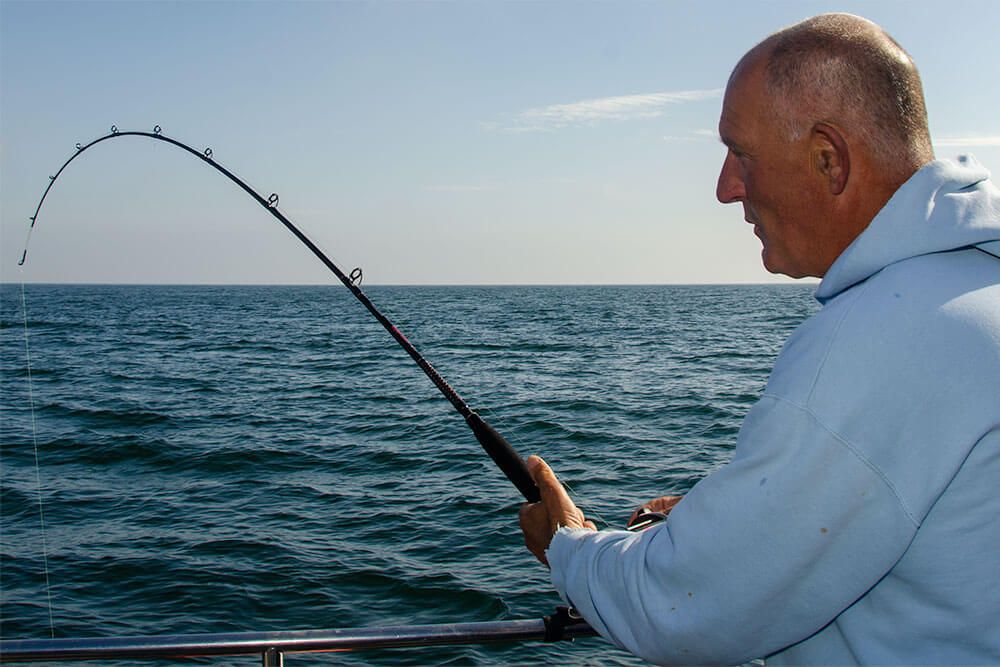
Shads and lures
It's important to carry a range of shads in different sizes. Cod can become preoccupied with a certain size of baitfish and if you use a lure that is either too small or too big in comparison, then bites will be hard to come by.
Small size 2.5-inch shads can work when the cod are on the sprat, but the more consistent shads are the 3in, 4in and 5in for general fishing. However, when the bigger cod are on the reefs and wrecks, they might be taking whiting or herring, then you'll need 6in to 8in shads.
It's the same with sandeel imitations, have a few smaller 4in ones, but then everything from 5in up to 10in, the latter being a representation of the launce sandeel which are often present over reefs and wrecks in deeper water.
There are consistent colours, but light levels coming down through the water column and the clarity of the water itself can dictate which colours work best on the day. In clear water in depths to 100-feet, white, yellow or rhubarb and custard (pink and yellow) can work well. In deeper water, the darker colours tend to come into their own with red, black, and blue being good ones to start with. Pink is also a colour cod like a lot.
If the day is overcast and light levels are low, go straight down with a dark red or black. In these conditions the cod are looking for a silhouette above them against the surface light. In water with less clarity after a rough sea, try the pink or a hot luminous colour such as green or orange.
To get the best from this method, and this applies to all lure fishing, you need to work the lures right in amongst the reef or wreck. Also work the lures up from the seabed a few feet at a time up to about the 20-feet mark, but no higher, if bites are slow. The cod will be on the bottom when the tide is running fast but may lift a little in the water column as the tide eases.
Whitby rig
The top rig for working all forms of lures is what was originally called the "Whitby Rig". This is dead easy to tie and uses minimal components, so is cheaper to lose when fishing into very rough ground or over reefs and wrecks.
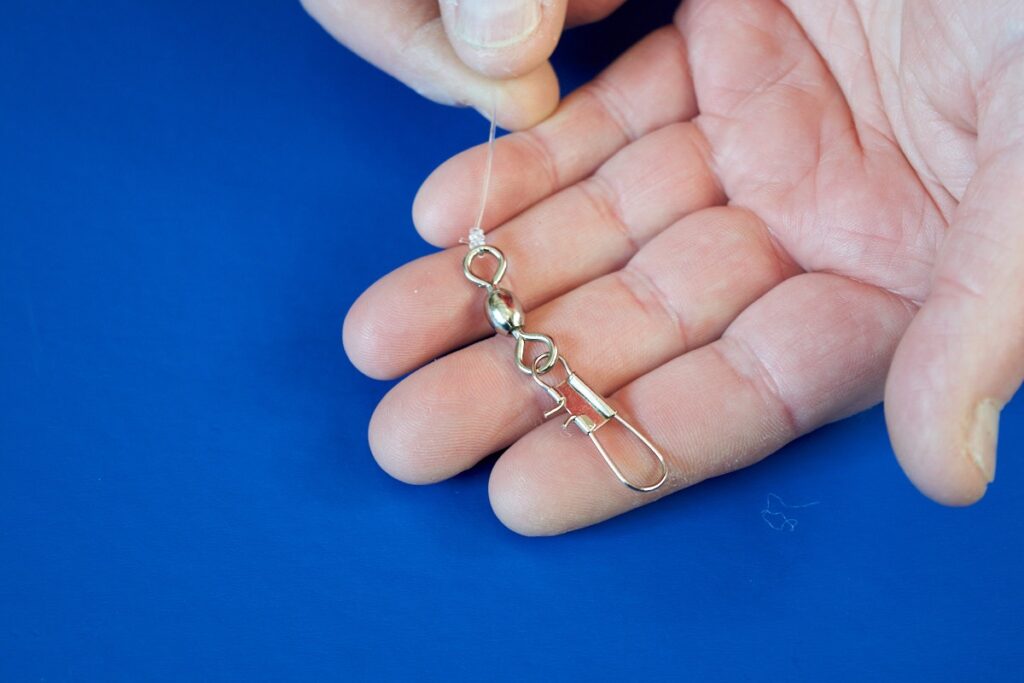
1. On to the shock leader tie on a size 2/0 American Snap Swivel.
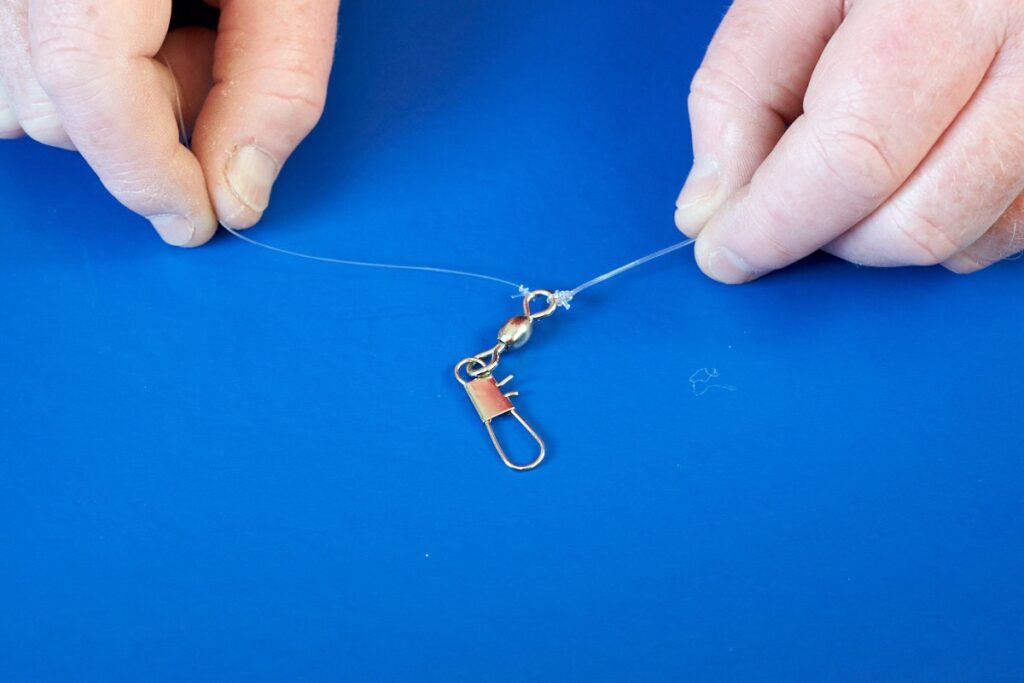
2. To the same eye you tied the leader to, tie on 7ft of 30lb Fluorocarbon line.
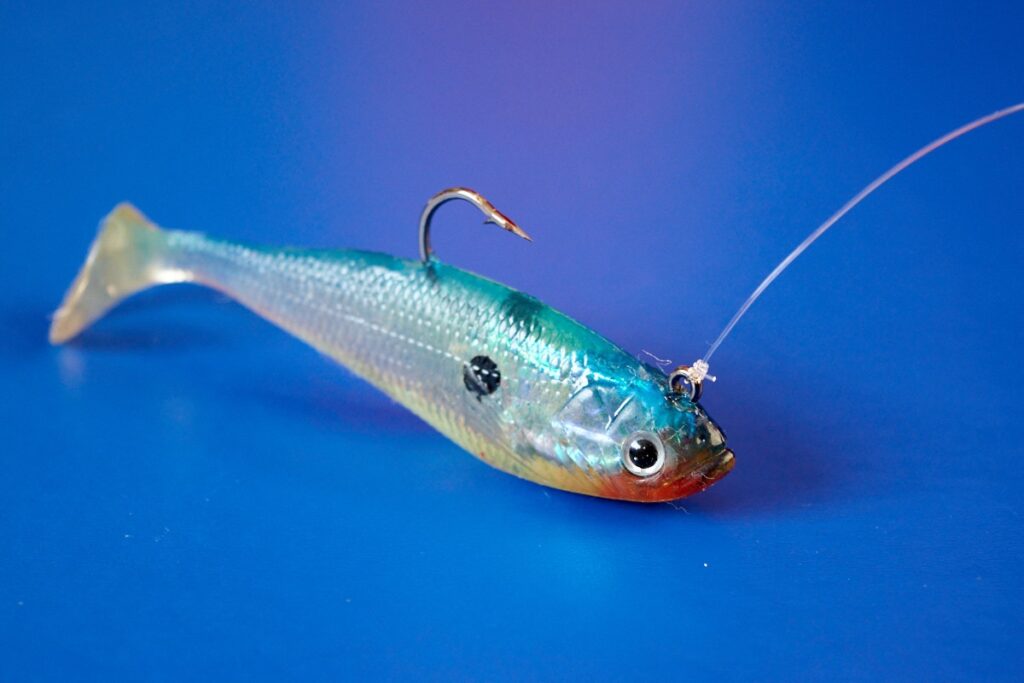
3. To the Fluorocarbon tie on the lure of your choice.
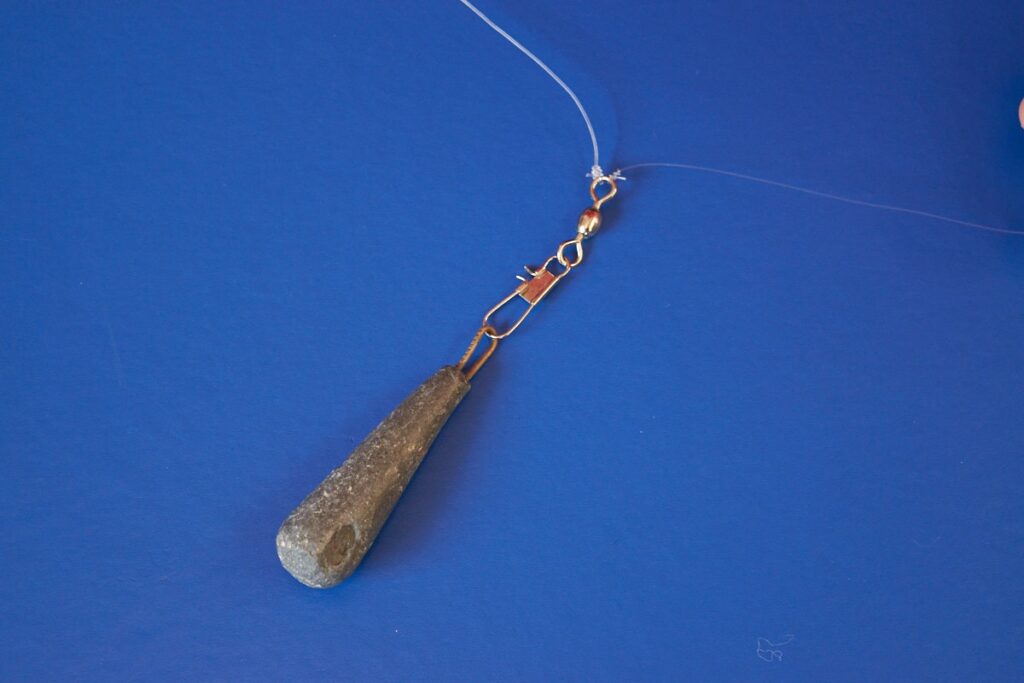
4. The lead weight attaches to the link on the Snap Swivel.
This rig works best with a weighted shad or sandeel. Due to the weight of the jig heads and weighted shads, as the main lead weight hits the seabed and the angler lifts the weight up off the seabed, the shad on the hook trace continues to fall pulling out, and minimising, any chance of tangles. Non-weighted lures may tangle sometimes!
You can allow the rig to descend at speed down through the water column, then when it hits the seabed, start to slowly wind in counting the turns of the handle so you can remember how far up off the bottom the fish are before you get a bite. Try different speeds to identify how fast the fish want the lure on the day.
This rig can also be "hopped" up and down just off the seabed. After the lead weight hits the ground, remember the length of the hook trace and wind in two or three feet more line than that onto the reel. You then lift and drop the rod tip a couple of feet keeping a tight line and this sees the lure lift and drop just above the seabed. The cod love this presentation but tend to hit the lure as it's dropping back down.
Flying collar rig
This is a rig from the 1970's but has stood the test of time through to the modern day. It is prone to tangling though, when dropped fast through the water column, but remains popular with many lure anglers.
The flying collar rig with its long trace is designed to flow out in the tide and present the lure as a natural swimming fish. With a lead weight attached to the booms lead clip, let the boom and lure slowly drop to the seabed pausing occasionally to let the trace flow out in the tide. The descent must be slow and controlled when the tide run is slow, not in free fall, as too fast a descent can see the long trace tangle above the boom. In faster tide flows the descent can be faster as the trace remains stretched out by the tide pull.
The swivel in the middle of the trace helps to reduce twist in the line and minimises potential tangles during descent, and if a lure or fish is prone to induce trace twist.
When the weight is felt to touch bottom, begin a slow retrieve and count the turns of the reel handle. Between 25 and 30 turns is a good rule of thumb. This works the lure up through the lower water column and above the wreckage or reef where the pollack, cod, coalfish and ling are feeding. After 30 turns or so, release the rig to the bottom and start a new retrieve.
Although this rig is ideal for use with a lead weight that is heavy enough to keep the line fishing virtually vertical, it can pay on slow to medium speed drifts to reduce the overall weight of the lead and allow the rig to flow away at an angle, but still be initially in contact with the seabed. Once you've released about 50-yards of free line, begin that slow retrieve. This brings the lure up at a much shallower angle and keeps the lure tighter to the seabed or wreckage for much longer. This is a good way to find cod and ling on lures, when others working the lure more vertically are catching only pollack.
When approaching slack water and the tide run falls away to next to nothing, then it pays to shorten the trace to no more than 10-feet. However, as the tide flow picks up speed again, you can lengthen the trace back to 12 or 15-feet and to keep the lure well away from the boom in case the boom spooks the fish.
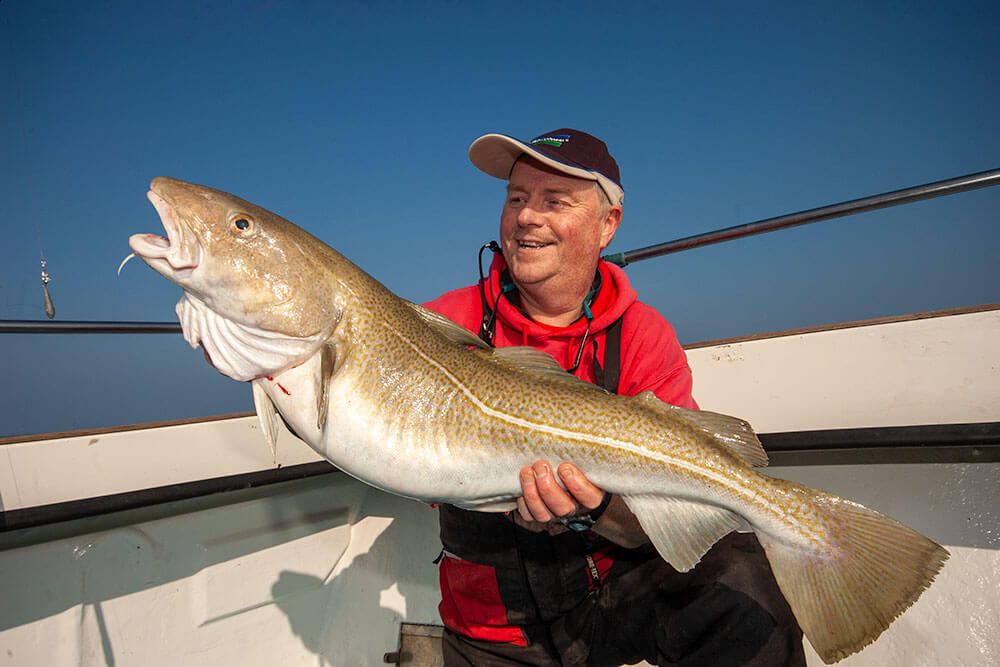
If the water is very clear in settled weather, change to a clear plastic boom as this can increase the catch rate. You can also make longer booms by buying hollow plastic tube from craft shops, drilling the centre hole out to a midway point in a Zip Slider boom, and pushing the long length of tube into the short Zip Slider Boom. But obviously make sure the drilled hole is a tight fit on the tubing.
Using fluorocarbon for the trace not only reduces the likelihood of tangles due to its stiffer nature than mono, but you will also find it catches you more fish as the fish are less inclined to see it. It is also more abrasion resistant when working tight to a reef, the seabed, or into sunken wreckage than mono is.
The flying collar rig is also a good way to present a whole mackerel flapper or other fish bait tight to the seabed. The build sequence is the same as before, but instead of a lure you use a single strong hook such as a size 8/0 O'Shaughnessy pattern. This is a good method for targeting the very biggest cod in the wreck.
Jumper rig
Another good rig is a variant of the Flying Collar called the Jumper rig. This uses the boom, bead, and swivel, but then you add between 4 and 6ft of 50lb mono and tie on a weighted shad. This is released to the seabed, lifted about 6ft up off the bottom and is worked by lifting and lowering the rod tip to make the shad swim up and down. This is highly effective for big cod working close into wrecks. That said, the more modern Whitby Rig is the preferred type by the TSF team.
You can also fish the bigger 6-inch shads on heavier 3 to 10oz lead heads depending on depth. Again, it's just a case of releasing the lure to the seabed then using the slow steady retrieve until the fish are found.
[*]When uptide casting, use what area you have between where you are and where the other anglers are casting. Vary casting distance and angle. Doing this you locate smaller different patches of ground, such as boulders and hollowed out areas, that consistently produce fish.[*]When baiting with whole squid, make sure the hook comes out through the head and not just the body. Cod can often nip off the head and leave the body missing the hook completely.[*]Black shads are great fish catchers but often hard to find in the shops. Always carry a black permanent marker pen and use this to colour lighter coloured shads to improve the catch rate.[*]Cod are sensitive to noise in the water and associate this with food. When bait fishing, try adding a double rattle bead, such as the Tronixpro Rattle Bead about 10-inches above the bait and locked in place by a wrap of coated jewellery wire, or a Powergum stop knot and bead.[*]Fish of any size will take the 9cm and 11cm shads, and sandeels of 6-inches and 8-inches, and these should be the sizes you begin fishing with. However, when very big fish are resident, then the larger shads of 20cms and bigger jig heads up to 10ozs can produce well.[/list]
About the cod
The cod's contribution to the world's growth and progression has been immense yet is little known. Dried cod has been a product for over a thousand years. It was salted and dried cod that sustained the Vikings on their epic journeys of raid, plunder and eventually to trade. There seems little doubt now that it was the Vikings that discovered the America's way before Columbus did, possibly 400-years earlier, and again, it was the cod that kept the Viking crews fed as they combed the North Atlantic for new lands to settle.
Even today, Norway exports salted and dried cod to around a dozen countries, Portugal being one of the largest markets. In Norwegian, salted, and dried cod is called 'Klippfisk" meaning "cliff fish" as the fillets of cod were dried on rock surfaces on cliffs or in wooden wracks on the hillsides where the wind flowed.
During the 1800's the Grand Banks off Newfoundland were the cod mecca with immense catches and fish over 100lbs caught on handlines from small dories launched from parent masted ships. It was said at the time that you could walk the Atlantic on the backs of cod, there were that many. Yes, an exaggeration, but it gives an indication as to how heavy in number the cod stocks really were! Even here though, the relentless commercial fishing took its toll and by the 20th century, it was but a shadow of its former self.
In the 1600's in Newfoundland cod was an actual currency and could be traded for alternative goods. It was literally called "cod currency".
The biggest cod ever officially recorded weighed 212lbs (95.5kgs). It was caught in May of 1895 commercially off the coast of Massachusetts on a handline. Even today cod over 100lbs are taken in Norwegian and Icelandic waters commercially.
If you're interested in reading more about the history of cod and how it has helped shaped the world, we recommend reading Cod: A Biography of the Fish That Changed the World by Mark Kurlansky. This work is an excellent biography of how wars have been fought, revolutions have been triggered and how lives and economies have depended on the cod. The book can be purchased via Amazon UK here.

Cod identification
Cod can only really be confused with the whiting. The cod has a more blunt, bigger head, but the whiting's head is more pointed towards the jaws. The cod's lateral line is more pronounced and features an upwards curve above the pectoral fin. Also look for a definite black or dark spot positioned at the root of the pectoral fin on the whiting, which is missing on the cod.
When living over sand cod take on a mottled fawn or light brown colouring on the back with a white underside. But when feeding mostly over mixed rougher ground and broken shell they become slightly greener on the back for better camouflage.
They achieve sexual maturity at the age of four and female cod can produce up to 10 million eggs. The fry are rarely evident, but by the end of their second spring can be found close inshore and will range from four inches to seven inches in length. Overall growth is rapid and by their third year they should weigh in the region of 4lbs, though are still not fully mature.
Cod spawn between February and April is depths of 200-meters plus. A large adult female can lay between four and six million eggs in one spawning. The eggs are transported on ocean currents to maximise the range of distribution.

Distribution
The Atlantic cod is commonly found along the northern half of the east coast of America down as far south as Maine. Along the coast of Newfoundland, Canada, around the southern half of Greenland, all around Iceland and throughout Norway as far as the Barents Sea off Russia and as far north as The Arctic.
Cod are found all around the UK with heavy concentrations in the North Sea, English Channel, Irish Sea, and off Scotland as far north as The Faroes. They are also common throughout Ireland but with the north-western coast from Mayo through Donegal and Northern Ireland tending to have the greater number of fish.
Cod habitat
Cod are a versatile fish being found off the shore in just a few feet of water right down to the edge of the Continental Shelf in depths of 2000-feet or 600-metres.
Inshore they are found on shallow and steep-to beaches over sand, inside small and major estuaries, and off rocky cliffs and scars over rough ground. Offshore they like rough ground in deeper water, especially reefs, also wrecks, but can also be found over cleaner more broken ground.
Diet
Cod are designed with a large mouth in comparison to the body for hoovering up food items off the seabed and sucking in the baitfish that they prey on. A typical cod diet includes crabs, worms, shellfish, shrimps, and squat lobsters, but as they grow bigger and start taking live fish, they add poor cod, pouting, whiting, flatfish, sandeel, herring, and mackerel. They are also cannibalistic and will happily eat their own kind.
Shore fishing for cod
Surf fishing for cod
Season
In Scotland and the Northeast of England cod can be caught pretty much throughout the whole year, though from September onwards numbers increase as more fish move in from deeper water.
In the south of the UK, the traditional start to the cod season is again September with the first fish generally showing from the shore marks in the upper Bristol Channel, from Dungeness Beach in Kent, and Chesil Beach in Dorset, The Tamar Estuary, and from the East Anglian, Lincolnshire and Yorkshire beaches.
In the west of the UK the season is much the same with September seeing the early vanguard of fish.
In all areas, numbers increase throughout October, with the peak period for shore cod being November through to Christmas. Come late January, cod numbers rapidly thin out as the fish move offshore prior to spawning.
In some areas, especially the East Coast of England and inside the Severn Estuary being examples, there can be what is called a spring run. This is a migration of smaller codling under 5lbs that come back inshore to feed during the late March to early May period. This is likely to coincide with the springs first real flush of peeling crab during the bigger spring tides of these months.
Tides
Cod like real movement in the tide indicating that it's the bigger spring tides that will provide the very best fishing. The prime tides are those that fall three days before the biggest spring tides. Once the spring tides reach their peak height of that cycle, the fishing will normally slow.
Ebb tides generally are less consistent, but on the deeper steep-to beaches where there is more depth, the ebb tides can still produce fish, though at lower levels than the bigger tides will.
On shallow surf beaches low water and right through the flood tide to high water can be a good time, but once the ebb starts typically the fish move further out, often beyond fishing range. On deeper Steep-to beaches, often the cod come in with mid-flood when the tide picks up speed, staying until high water, but it will vary from beach to beach.
When fishing a shallow surf beach that has a rough ground or reef around the low water mark then fishing the middle ebb, if you can cast to the rougher ground, can often produce good fishing.
Weather patterns
Cod like rough seas with a good swell and a surf running. This displaces food from the sand and the cod move in to feed. Big Atlantic low pressure weather systems that bring gale force winds in from the southwest and west are the ones to watch for. As these produce surf and swell as they approach this can fish well, but the best fishing is after the gale blows through and the wind drops but the sea remains rough. Big catches can be made in these conditions.
Cod can be caught by day if the water is very coloured and ideally over 15-feet in depth to minimise light passing through the water column. But experienced cod anglers will always fish at night, as this is when the bulk of the fish move inshore to feed.
Habitat
On shallow beaches, look for specific stand out ground features. Deeper sand gullies running parallel with the shore trap food pushed in by the tide and will hold cod. Note any areas where patches of shingle, broken boulders or mussel beds lay as these will hold food and the cod will visit. Junctions of boulders and sand are good, also channels between sandbanks where the fish will pass through as the tide floods in. All these are cod hotspots.
Also target any bigger areas of rough ground, especially where there are a mix of smaller and bigger boulders.
Take the time to study the surf pattern on deeper beaches. Any areas where the surf breaks closer in indicates deeper water and are well worth fishing. Also look for areas where flotsam and jetsam, bits of wood and man-made rubbish, washes up on the shingle above the sand line as these identify a tide current that washes ashore here and will bring food with it. Also, any out jutting rock or shingle banks that defect the tide will again draw cod in to feed. Especially good are areas where there are deeper depressions as these will trap and hold food as the tide flows over them.

Tackle
Two outfits cover all surf fishing eventualities. The first, for general surf fishing, is a 14ft European style rod rated to cast up to 6ozs. For rougher seas a rod rated up to 8ozs gives added power and the ability to cast very big baits. This teams up with a 7500 sized fixed spool reel. A good choice is one with a modern "long spool' designed for braided line. An example is the Penn Spinfisher 7500LC. Load this with 30lb braid and add an 80lb braid shock leader. This outfit will maximise your casting range even with simple overhead casting styles and distance can often be critical when it comes to reaching surf cod.
If you use a multiplier reel, then look at a powerful fast taper, 5 to 6oz beachcaster between 12ft and 14ft. Most anglers opt for a rod between 12ft 6ins and 13ft 6ins. Over clean sand popular reels to go with this rod for maximum casting distance, which again can be a major advantage on many cod beaches, are the Abu 6500i TSR and the Daiwa 7HT series loaded with 15lb line and a 60lb shock leader, also look at similar sized reels from Akios. For rough seas and when fishing in amongst broken ground, most anglers prefer the increased winching power of the Penn 525Mag3, Daiwa SLOSH or the Penn Fathom Casting Special or modified casting versions of the original Fathom reel and loaded with 20lb line and an 60lb mono shock leader.

Clipped down pennel pulley cod rig
The clipped down pulley rig, over the past 20-years or so, has established itself as THE most efficient cod rig for surf and rough ground cod fishing. Really, you don't need to consider any other rig for normal situations and conditions. Here's how to build it.

1. Begin with a 44-inch length of 60lb mono line. Tie on a Gemini lead clip link at the base.

2. Slide on a 5mm bead, a size 4 rolling swivel, or better still a Pulley Rig Bead, and another 5mm bead.

3. Below the last bead, tie in a figure-of-eight knot to form a 20-inch hook length.

4. The two-hook Pennel rig uses a Mustad Viking 79510 top hook, and a Viking 79515 lower hook, both size 4/0’s. Slide the top hook on to the hook length via the eye. Now tie on the bottom hook. To secure the top hook after baiting up, position the hook about an inch above the bait, wrap the hook length around the shank of the top hook three times and pass the hook point in through the top of the bait for perfect presentation.
5. For casting, put the bottom hook in the clip of the lead clip link to tension the hook trace. The hook will fall free of the clip when the lead weight hits the sea's surface.
The TSF team likes to make this rig with 60lb mono all the way through. This adds strength to bully fish, helps to limit tangles when fishing heavy surf tables, and the heavier diameter 60lb mono combats the needle like teeth of the cod to limit abrasion.
This rig needs to be fished with a release wire lead weight, this to anchor the bait down in the heavy surf and make the bait an easy to attack target for the hunting cod. Leads with a long wire tail rather than a single short eye loop will hold better acting much more like an anchor in seas that are churning up the seabed. It is always worth carrying a few of these leads. They are also more stable in flight and fly like a dart preserving bait presentation when using bigger lugworm baits.
Also make sure that the hooks are always sharp and resharpen if necessary. Cod will hit the bait on the run and lift the lead weight out of the sand. This can be enough to set the hook themselves providing the hooks are sharp.
Baits
Black and blow lug are the top boats for cod in the surf. In the case of black lug, if they are fresh, nip the sandy tail off then thread them on to the hook tail first pushing the worm right around the bend of the hook and up the hook shank and only the mono between the two hooks of the Pennel rig. One big worm may be enough, but if in doubt, use two worms. The worms will normally burst so compress the worm or worms down the hook aiming to get a bait about 5 to 8-inches long and then bind it with a little bait elastic to make it secure for casting.
You can use blow lug in the same way pushing several onto the hook, round the bend and up the shank to create that bigger bait. You can also combine a main black lug bait with one or two blow lug at the hook point to put the main scent right at the point to attract the cod to take the bait at that end.

King ragworm is another good worm bait, but it works better when it's combined with black lug. In many areas, king rag is less effective as a standalone bait for cod. Presentation is again the same as for black and blow lug.
Squid can be used whole for cod but is better cut as a strip that is used as a splint down the length of the lugworm or added as a short three inch strip at the hook point. If you use it whole, then pass the lower hook of the Pennel rig down through the lower half of the squid and push the top hook in at the top. Bend the squid head back on itself so that it sits under the body, then bind the whole lot securely together with bait elastic. One whole squid is enough for surf fishing.
If you're fishing near rocks or patches of boulders, and even over clean sand, mussels can be excellent. The way to prepare mussels ideally, is to skeen (take out) the mussel flesh from the shell and drop them into a jar or sealable plastic container a good 24-hours before you fish. The mussel will then steep in its own juices and becomes more effective than when fresh out of the shell. Using three or four mussels, depending on overall size, push them up the hook to form a sausage shape about three to four inches long, then bind with bait elastic. A splint of squid down one side can add some stiffness and added security to this soft bait, alternatively, a length of black lug. Keep the lower hook point clear of the mussel and push the top hook in at the top of the bait.
Peeler crab can be excellent throughout the year both when fresh, especially in the spring, but also fresh or frozen during the winter run. The best way to present peeler crab is to take a whole crab, peel all the legs and the soft shell off it, cut the soft body in half lengthways across the body, then slide both pieces onto the hook. Again, it's a sausage shape you are looking for with a length about three to four inches, then bind with bait elastic.
Other shellfish, such as razorfish and queen cockle, can be killer baits to tip the worm off with just after a storm has passed through. These get naturally washed out of the sand by the pounding surf and the fish will be hunting for these.
In our experience, fish baits generally, such as mackerel, herring are a virtual waste of time for surf cod. In some areas, sandeel can take fish, but it is far less reliable than worm and shellfish baits.
Technique
The first step to successful cod fishing is to find those features on the beach at low water on a big spring tide when the water goes further out. Use shoreline or backdrop ground features such as sand dunes, trees, or a house, to get a bearing where the feature is from where you will cast. Getting baits into depressions, gutters or close to hard patches will make a huge difference to your catch.
Fishing two rods, if conditions allow, means you can target two different areas at different casting distances, say a gutter and a patch of rocks. Also, having two identical rods fishing side by side means you can compare the two regards bite detection, especially if you get a slack line or drop back bite and miss seeing it, which with cod, can often be the case. Two identical rod tips act the same, so a different response on one rod tip compared to the other suggests action is needed.
Cod also tend to come through in waves, especially the smaller fish. Having the two baits fishing means even when landing a fish or re-baiting, you still have one bait in the water to fully capitalise on potential bites.
When casting into a strong headwind use the biggest lead weight you can comfortably cast. A 6oz weight will penetrate through a strong oncoming wind better than a 5oz, and a 7oz better than a 6oz. This is due to the momentum and mass of the lead retaining power longer, therefore travelling further to increase your casting range. Heavier grip leads also hold better in rough seas and anchor the bait where the cod can find it. You can also get release wire leads to hold better by wrapping an elastic band around them for added grip.
Another good tip is to use brightly coloured shock leaders at night. These are easily seen and picked up in your headlight beam and will indicate exactly where a fish is in the surf tables prior to landing. It also gives the man landing the fish something to hold and then slide the fish ashore with until he can grab it by the gills.

In water not too coloured, adding a couple of luminous green beads charged under your headlight, camera flash or dedicated UV Light, will draw cod towards your bait and will increase catches. Use small beads no more than 4mm in diameter and make sure they are highly luminous for maximum effect.
Cod bites are mostly dramatic, the rod tip may knock a couple of times as the fish takes the bait in, but then as it moves away and pulls the lead weight out, the rod tip will pull hard down, thump a couple of times, then spring back straight. These fish are mostly already hooked, but it's wise to quickly wind in any slack line until you feel the weight of the fish, then lift the rod tip to fully set the hook.
Bigger cod will thump the rod tip and shake their heads, but usually stay heavy on the rod tip until they feel the shallowing water then will make short runs parallel with the beach. They prefer to run with the tide and can take some line, but they will quickly tire. Look for the leader in the edge of the surf and for the flash of water as the cod twists and turns in the shallow water. Keep the line tension tight, wait for a wave to push inshore and let the wave wash the fish on to dry sand. If you bully fish and try and slide them in with the rod, then that is when a light hook hold can pop.
Surf fishing for cod top tips
[*]Getting to a beach just as a gale and rough sea is dying away and prior to low water can often reveal scoured out shellfish laying on the sand. These include razorfish, queen cockle, scallop, and sand clams. Tipping lug and ragworm baits with these can again increase your catch as this is exactly what the cod have moved into the surf to feed on.[*]Don't leave baits longer than about 15-minutes. Worm and shellfish baits will wash out quickly and cod, at night and in dirty coloured water, are hunting mostly by scent, so keep the baits fresh by re-baiting regularly.[/list]
Rough ground cod fishing
The knack to finding the bigger fish will generally be to fish the rough ground and the heavier seas. If you're frightened of losing a lot of tackle, then rough ground cod fishing maybe isn't for you.
There are generally two types of rough ground. One type is an open beach with a seabed of boulders or rocky fingers in relatively shallow water. These occur in many areas and are prime cod ground. The cod usually run these beaches from low water up to high water, then move out. The two hours after low water and the hour either side of high water often tends to be best. Surprisingly, the middle hours of the tide on many beaches do not fish that well in comparison.

On these shallower beaches the bigger spring tides invariably fish best as the increase in tidal speed scours out the ground and exposes more food. The best time to fish these beaches is immediately after a good storm when the surf remains high, but the wind has dropped. This big sea further scours out any sand sitting between the stone and rock and washes out food such as worms and shellfish, plus it smashes mussels free from the rocks.
Because of the shallow nature of these beaches, it pays to fish only at night. Even when the water is well coloured after a storm, most fish will stay out in deeper water during daylight.
Try to look at the beach over low water. Pick out any obvious gullies or gutters that cut in towards the shore with slightly deeper water. These will catch and hold food washed along by the tide, plus are natural motorways for the fish to work through. Also identify scooped out areas around bigger boulders, small sections of shallow reef running inshore and any large rock pools, as once flooded by the tide, these will all concentrate food and fish.
On these shallow beaches, a long cast may be necessary to find the fish, especially over low water, but it's far more important to have your bait in, or tight to the described fish holding features. It's often the case that the cod are close in as the tide starts to flood, but move further out during the peak tidal flow, so adjust your casting as necessary.
Rock ledge and scar fishing
The second type of ground tends to be casting from rock ledges, rock platforms or rock scars into deeper, much rougher ground made up of rock gullies filled with kelp weed and covered in barnacles. This ground is typical along the Northeast coast of England, some parts of east and west Scotland, also areas such as Anglesey and Cornwall.

The gullies can be narrow and just a few feet across, or much wider with depths again from just a few feet to maybe 20-feet deep or more. They often have kelp and other weed growth evident, with rock covered in barnacles and mussels. These gullies are full of natural food including small fish such as shannies and blennies, crabs, and mussels.
The deeper gullies will fish in daylight as the fish have more cover, and especially if there is some colour in the sea, but again night-time generally is best for the more consistent catches.
Safety needs to be considered, but as before rougher sea conditions with a good swell tend to bring the fish in to the gullies. A good onshore wind is essential for the winter fish, though red summer rock cod can be caught in calmer conditions in a good depth of water.
This type of ground requires accurate casting, aiming to put the baits directly into the gutters where the fish are. Sometimes you'll take fish at just 20-yards range, though most casting will require accurate casting up to 70-yards. Good anglers, experienced over this type of ground, will fish at much longer range as appropriate to pick out their favoured gullies.
Tackle
In both cases, rough ground beaches and when fishing from rock ledges and scars, this can be brutal fishing, so a powerful, very fast taper blank rated to cast 6ozs is necessary. Length can be 13 to 14-feet, but make sure the rod is stiff to literally bully and drag fish over and out through snags. The extra length of rods of 13ft or more helps give you more steerage of hooked fish and keeps the rod tip up and out when the fish are close in ready for landing.
For the shallower beach a Penn 525Mag4 is a very popular reel as it has the tough gears and build quality required, but equally can hit long range. Main lines from 18 to 25lbs are typical, depending on casting range needed, with a 60lb shock leader.
For the very rough ground some Shimano and Avet reels have a larger line capacity. Load these with 25 to 30lb line main. For short range casting there is no need for a leader with the 30lb line, but for long range work you will still need a 60lb shock leader.
Some anglers are also using the longer 14ft to 15ft European rods, especially those rated to cast 200g. These are matched to a 7500 or 8000 sized reel and loaded with 60lb to 80lb braid line. The longer rod gives greater reach and leverage against a fish and the heavier 60lb plus main line obviously allows you to really bully a fish through the kelp and snags.
Rough ground cod fishing rig
Because we're fishing in very rough ground, we need to beef up the rig for added strength and abrasion resistance.

1. Begin with a 44-inch length of 80lb Rig Body line. Tie on an inverted (upside down) Gemini bait clip link at the base.

2. Slide on a 5mm bead, a Pulley Rig Bead, and another 5mm bead.

3. Below the last bead, tie in a figure-of-eight knot to form a 20-inch hook length.

4. The two-hook Pennel rig uses a Mustad Viking 79510 top hook, and a Viking 79515 lower hook, both size 4/0's. Slide the top hook on to the hook length via the eye. Now tie on the bottom hook. To secure the top hook after baiting up, position the hook about an inch above the bait, wrap the hook length around the shank of the top hook three times and pass the hook point in through the top of the bait for perfect presentation.

5. When fishing rougher ground, tie a short section of weaker 20lb line to the eye of the inverted Gemini clip link, then tie the free end to the eye of a lead. The eye of the lead then sits on the actual bent wire clip of the inverted Gemini clip for casting. The lead will fall free of the bent clip when the lead weight hits the sea. The 20lb weak link will snap relatively easily meaning you only lose a weight and not a fish or whole rig.
Alternatively, if you need to clip a bait down, then instead of adding a clip directly on the rig, tie on a Gemini bait clip as normal, then add an upside down one into this. For casting, put the bottom hook in the clip of the lead clip link as normal, tie on a weak link of line between the eye of this link and the eye of the lead, then place the eye of the lead in the clip on the upside down clip link. The hook will fall free of the clip when the lead weight hits the sea's surface.
Rough ground cod baits
Over both types of ground big lug baits up to 8-inches long work well or mix both rag and lug as a combination. You can tip this off with a strip of squid, or a full razorfish bound along the length of the lugworm, the latter improving the security of the softer worm bait for longer range casting.

Other good baits are several big mussels bound onto the hook into a sausage shape. Use enough bait elastic to fully secure the mussel otherwise it will fly off during the cast.
Peeler crab is good bait, both fresh and frozen and will catch throughout the year but is best in the autumn and spring. Take the legs off a dead peeler crab, peel all the shell off the crab body, then cut this into two halves. Push both sections of crab up the bend and hook shank then bind with bait elastic to secure the bait. This will leak lots of scent but in this rough sausage bait presents the hook point well clear of the bait for easy hooking.
Whole squid are also a good bait. Squid no longer six inches are ideal for shore fishing being easily taken in by average cod, but also small enough to cast well. Thread the bottom hook of a Pennel rig in through the top end of the squid and pass down the body to bring it out near the head of the bait. Put the top hook in through the top of the bait once to bring the hook point fully through. Bend the head of the squid back under the body then bind it together with bait elastic to fully secure the bait for casting.
Rough ground cod fishing tips
[*]Leads specially made with soft release grip wires that bend under pressure often snag less than plain bomb and normal grip wired leads. The wires help keep the leads out of the cracks that weights typically jam in. These also keep you anchored in the rough ground and will not roll around in any tide run either.[*]Some anglers prefer to use a big fixed spool reel and load with 50, even 60lb braid line to give greater lifting power, especially when fishing at short to medium range into very heavy snags. This requires no leader, plus gives excellent bite detection when holding the rod and feeling for bites.[*]It pays to have one rig fishing and another ready baited with a link attached to your leader for a quick change. Often a small group of cod will pass through over a short period giving you the chance of two fish if you have a ready baited rig available.[*]In semi coloured water, and when night fishing, adding a luminous yellow bead immediately above the hook can sometimes increase your catches. Make sure you charge the bead under your lamp or torch beam before casting.[/list]
Boat cod fishing
Boat cod fishing season
Cod are resident on the inshore reefs and offshore wrecks for much of the year all around the UK, though tend to be smaller fish up to 7lbs during the summer and early autumn in many southern areas. In the north, off Yorkshire, the boats take good cod to 10lbs off the inshore grounds but are always in with the chance of a 20lb plus fish when fishing the wrecks during the summer. The inshore rough ground also provides excellent fishing through much of the winter here. Throughout Scotland the inshore cod run to 8lbs or so, with the occasional bigger fish throughout the year.
In the south, the bigger fish move inshore from September in areas such as the Thames Estuary and Bristol Channel, staying until January. But it's from January through to March that the big cod begin to move out on to the wrecks and gather for spawning. This is when the bigger fish over 20lbs and 30lbs are caught.

Diet
Although big cod will grub for food on the seabed, for the most part they are predatory eating small fish such as sandeel, pout, poor cod, rockling, whiting, small cod, flatfish, herring, mackerel, crabs, squat lobster, and any shellfish they come across.
In the winter, when the sprat move close inshore during calm settled weather, the cod can become preoccupied on these and move up off the seabed. Catching cod at this time can be difficult.
Uptide fishing
Uptide fishing is the most successful technique when anchoring in fast tides areas such as the Bristol Channel, Thames Estuary, and the Mersey Estuary, but can be utilised anywhere when the boat is anchored.
Uptiding means the angler casts the baited rig in a sharp uptide direction, then as the lead weight hits the seas surface, begin releasing line again until you feel the weight touch bottom. Release a further 20-yards or so of line, then click the reel in to gear. The release of line after the lead hits the seabed creates a big downtide bow in the line that sees the line bow below the rig and the weight pull the grip lead deep into the seabed and anchor the bait, much like a boat's anchor rope does. The rod tip now pulls steadily over into the tide.
Bites will register typically as a double knock, then a sharp pull down and the rod tip will spring back straight as the fish pulls the lead weight free. Lift the rod, wind down until you feel the weight of the fish, now lift the rod to strike and fully set the hook.
When casting uptide, try different casting distances and vary the angle you cast into the tide. In this way you can search the ground to try and identify small areas where bites are more numerous. Trust us, this is a common thing that certain small patches of ground will produce the most fish. It may just be a depression in the seabed, possibly just a heavier cluster of stone, but it's enough to see fish visit it.

Uptide fishing tackle
Typical uptide rods for cod will be between 9'6" and 10' in length with a very supple tip, but powerful midsection and butt to give the casting power. Cod uptide rods are rated 4 to 10ozs or better still 6 to 10ozs.
Reels need to be able to cast to a good range but have powerful gears and frames. Popular reels are the Penn 525Mag4 loaded with 20lb line and a 60lb shock leader, though some prefer to use 25lb line and dispense with a shock leader as you are not power casting.
Some anglers prefer to use a big 8000 fixed spool reel loaded with 30/40lb braid and dispense with a shock leader. The extra winching power of the fixed spool, and its ease of casting, is well worth considering if you're new to uptide fishing.
Uptide casting rig
A simple and quick uptide rig that doesn't tangle can be tied as follows.
- Take 20-inches of 80lb rig body line and tie on a size 4 rolling swivel.
- Slide on a Zip Slider Boom, a 5mm bead, and tie on another size 4 swivel.
- To the end of this swivel add 3 to 6-feet of 40/50lb mono.
- Slide on a size 4/0 Mustad Viking 79510 hook by the eye, then tie on a Mustad Viking 79515 hook to the end of the line. Bait up, then slide the top hook down to the bait and wrap the hook trace around the shank of the hook three times to secure it in place. Position the hook point through the top of the bait for perfect presentation. For big squid baits use 6/0 hooks.
- The lead weight is attached to the link on the Zip Slider Boom.
The lead weight is important as it dictates the effectiveness of the rig. There are two types of lead you can use for uptide fishing.
One is the standard release wire grip lead. This needs to have the wires where they come out of the lead body and before they turn the corner to rise above the lead to bend down so that they fit very tight in the grooves of the lead to increase the pressure needed to release them. You can add further grip by looping a rubber band over one of the legs, then wrap it around the legs and body to increase the pressure on the release wires. This works well if you release enough line to create a big bow and when you're fishing tides that are not overly powerful.
In areas where tides are faster and you need more grip, then change to a lead weight that has the wires permanently fixed in the nose of the lead. These are often called "Sputniks" because they look like the Russian space satellite launched in 1957 with its trailing antennae. It's the same principle, releasing enough line to create a big bow, then the wires in the nose react exactly like an anchor and dig in to keep the bait fishing effectively. The weight will lift off the seabed when the cod turns into the tide and swims away after taking the bait.

Baits
For uptide fishing big lugworm baits are excellent. Use one or two whole black lug depending on length, then add several smaller and juicer blow lug at the bottom for added scent. These need to be formed like a thick sausage shape, bound with elastic thread, and be from six to nine inches long. After each retrieve, leave the old bait on and add fresh to maximise scent and bait size. Adding strips of squid for movement, mixing ragworm with the lug, and tipping with crab, razorfish and mussel can also be highly effective.
To target much bigger cod try fishing whole big squid or cuttlefish, or two or three smaller squid.
Half and full sections of bluey, also whole mackerel cut as a flapper, and herring can work around wrecks and reef ground.
To create a flapper mackerel bait, hold the tail of the mackerel in the non-dominant hand, place the knife at the root of the tail and take the full fillet off the bone right up to the gill, and on both sides, then cut the backbone out at the head leaving the fillets attached to the head. Pass the hook through both jaws of the mackerel with the point facing upwards.

Boat lure fishing for cod

Pirk fishing
During the 1960's, boat anglers fishing the deep water wrecks, pretty much breaking new ground at the time, found that metal pirks up to 12-inches long proved very effective for catching big cod over 20lbs.
This was physically demanding fishing with the pirk having to be worked on the rod tip by lifting it up and down in the deep water to give the pirk movement. This is a method that still works today but is used far less in current times.
The pirks were made either from chrome car door handles, which were common on 60's and 70's cars or made from chrome tubing flattened at one end with a hammer, filled with lead, flattened at the other end, then holes drilled in the flat ends to take heavy duty split rings for hook and swivel connection. It must be said that chrome is very effective due to it reflecting any available light, but many anglers fished copper pipe filled with lead or any other pipe and even the darker colours caught fish pretty much just as effectively.
There are also many forms of pirks made commercially, some of the best being the Solvkroken ones that have a bend in their length allowing them to move erratically in the water when worked. These are proven in Norwegian and Icelandic waters and have taken some huge cod over the years.

Tackle needs to be heavy. 30lb class rods with reels such as Penn Fathom 25's or 30's loaded with 50lb braid and a short 60lb fluorocarbon leader to separate the coloured braid from the lure and to add some abrasion resistance should the line immediately above the lure meet seabed debris or the wreck.
You can improve the effectiveness of pirks by adding either luminous green or pink tubing to the shank of the hook or add a pink or lumo green or yellow muppet to the hook shank, this to add both colour and more movement.
The major downside to pirk fishing is that fish are easily foul-hooked due to the constantly erratically moving pirk being hard to predict and hit for the attacking fish.
When working pirks, keep the pirk close to the seabed, typically around two or three feet above, but also try higher, especially at low water as the fish can move higher then as the tide slackens off.
Another trick when fishing a pirk, is to have a short 10-inch hook length of 40lb line with a small clip link on tied about four feet above the pirk. This is called a "flyer" and maybe the pirk imitates a predator about to attack a smaller bait fish. What it does is position a lure up off the seabed and this will take any cod that are swimming up off the bottom.
Killer gear rig
This is another very effective but somewhat old fashioned style of fishing. It can be fished either with a lead or with a pirk.
- Begin with 48-inches of 80lb line and tie a Mustad Oval Split Ring size 3/0 at one end.
- About 20-inches up from the Split Ring tie in a blood loop making sure the finished loop is at least 6-inches long.
- 44-inches above this tie in another blood loop. This wide distance between the bottom and top loop is deliberate. When a big fish takes the top lure and another is hooked on the lower lure, it allows the big fish to be netted on the surface at the side of the boat, while the other fish is still well down in the water and less likely to break free or tear the hook hold out.
- Finish the main rig by tying on a strong size 1/0 rolling swivel.
- Cut the blood loops close to the knot on one side only to create a single 12-inch long hook snood.
- When using muppets, slide the muppet on to the line, then slide on a 5mm bead, then tie on an O'Shaughnessy type hook size 4/0 to 8/0 to suit the lure size.
- When using artificial eels or Jelly Worms, just slide the eel or worm over the hook and on to the shank with the hook left well clear. Good hooks are Mustad 79515's in size 4/0 to 6/0 for lures.
- To present shads, again just slide the hook through the body and bring it out the back of the shad facing upwards. The proven Mustad 79515 hook is ideal for most shads in sizes 3/0 to 6/0.

The rig is best fished on 30lb class tackle capable of landing two large fish at once.
It's important to use a lead weight heavy enough to keep the line fishing almost vertically. If the line is streaming off downtide because you're using a weight that is too light, then your chances of snagging the reef or wreck are much greater. Learn to adjust the weight of your lead to the boat speed and the flow of tide aiming to use just enough to keep in vertical contact with the seabed, but no more.
Fishing this rig is easy! Using a heavy weight to punch through the smaller fish, allow the rig to descent fast as it can't really tangle, touch bottom, then retrieve just two or three feet of line, then lift and lower the rod tip in a slow and methodical lift of the main arm to work the lures in an up and down sequence. This simulates small fish swimming in the water column.
A good tip is to change the weight for a chrome coloured pirk. This has the weight to power through the upper water column shoal fish, but presents a big, fluttering target when worked that adds vibration and attraction, and by itself can take big fish. You can also add another muppet to the hook on the pirk for more movement and attraction.
The colours you choose for the muppets can be critical to what you catch. Cod favour pink muppets, but will also take white, yellow, red, and black on the day, even luminous green ones. Of course, all colours work, but these named colours do tend to pick up a higher percentage of these individual fish. Also try mixing two colours on the same rig.
As for artificial eels, such as Redgills, Eddystone Eels and Power Worms, then black bodies with either a red tail or yellow tail, often called Firetails, work well, or all red or white bodies. Sidewinders are a great lure too, especially the Rhubarb and Custard colour.
The same applies to shads. The top fish takers are black, red, clear blue and white. Anything with sparkle in it also works. The Berkley Ripple Shads are a hot lure as they have ripples formed in the sides that add much more vibration and these also take a lot of fish in all sizes.
And remember you can ignore the lures and choose to fish just two baited hooks or add a long strip of mackerel to the hooks used on the muppets. This little dodge often increases the catching power of this rig on days when bites are difficult to come by. It's also ideal for drifting scattered wreckage over more open ground by just keeping the lead in touch with the seabed to fish the baits dragging tight to the bottom. This is often how the biggest ling and cod are caught.
To limit tackle loss, you can also tie to the oval split ring to a few inches of lighter line. This should be about 20lbs and will break off should the lead weight get caught in a snag. This simple trick can save otherwise lost fish and end tackle for the loss of a sacrificial lead weight.
Soft lure fishing
Modern sport fishing trends now dictate that most anglers prefer to fish artificial lures for the wreck and reef dwelling cod. These range from artificial sandeels and jellyworms, weighted sandeel imitations such as the Berkley Powerbait Sandeels and Sidewinders, also soft shads such as the Berkley Ripple Shads fished on a lead head, and the weighted Storm and Savage Shads and sandeels.

Tackle
Tackle for working soft plastic or rubber lures, even in deep water, does not need to be overly strong. Over shallow reef ground in gentle tides an 8ft 12lb class rod with a reel such as the Penn Fathom 15 loaded with 20 to 30lb braid is perfect.
For deeper water and faster tides, a 12/20lb class rod, or possibly a 15lb class rod between 7ft 6in and 8ft with a supple tip but power in the mid-section and stiff butt is impossible to beat. Stick with the Penn Fathom 15 or a similar reel and load with 30lb line.
Occasionally, when working over ground in less than 80ft of water lighter tackle can be employed. This would be a 12lb class rod with one of the modern baitcaster multiplier reels loaded with 20lb braid. This is perfect for working weighted shads and sandeels and still has the power to beat big fish.
In all cases do add a shock leader of fluorocarbon in the same breaking strain as the main line you are using. This needs to be a little more than twice the length of the rod to allow a fish beaten on the surface to be drawn to the boat side with the shock leader already wound a few times onto the reel.
Lead shapes need to be streamlined, so go for torpedo shapes, bomb shapes or ball shaped weights. These fall through the water column cleanly without any tendency to veer off to one side. Leads with flat sides can sometimes be erratic in the way they fall.

Shads and lures
It's important to carry a range of shads in different sizes. Cod can become preoccupied with a certain size of baitfish and if you use a lure that is either too small or too big in comparison, then bites will be hard to come by.
Small size 2.5-inch shads can work when the cod are on the sprat, but the more consistent shads are the 3in, 4in and 5in for general fishing. However, when the bigger cod are on the reefs and wrecks, they might be taking whiting or herring, then you'll need 6in to 8in shads.
It's the same with sandeel imitations, have a few smaller 4in ones, but then everything from 5in up to 10in, the latter being a representation of the launce sandeel which are often present over reefs and wrecks in deeper water.
There are consistent colours, but light levels coming down through the water column and the clarity of the water itself can dictate which colours work best on the day. In clear water in depths to 100-feet, white, yellow or rhubarb and custard (pink and yellow) can work well. In deeper water, the darker colours tend to come into their own with red, black, and blue being good ones to start with. Pink is also a colour cod like a lot.
If the day is overcast and light levels are low, go straight down with a dark red or black. In these conditions the cod are looking for a silhouette above them against the surface light. In water with less clarity after a rough sea, try the pink or a hot luminous colour such as green or orange.
To get the best from this method, and this applies to all lure fishing, you need to work the lures right in amongst the reef or wreck. Also work the lures up from the seabed a few feet at a time up to about the 20-feet mark, but no higher, if bites are slow. The cod will be on the bottom when the tide is running fast but may lift a little in the water column as the tide eases.
Whitby rig
The top rig for working all forms of lures is what was originally called the "Whitby Rig". This is dead easy to tie and uses minimal components, so is cheaper to lose when fishing into very rough ground or over reefs and wrecks.

1. On to the shock leader tie on a size 2/0 American Snap Swivel.

2. To the same eye you tied the leader to, tie on 7ft of 30lb Fluorocarbon line.

3. To the Fluorocarbon tie on the lure of your choice.

4. The lead weight attaches to the link on the Snap Swivel.
This rig works best with a weighted shad or sandeel. Due to the weight of the jig heads and weighted shads, as the main lead weight hits the seabed and the angler lifts the weight up off the seabed, the shad on the hook trace continues to fall pulling out, and minimising, any chance of tangles. Non-weighted lures may tangle sometimes!
You can allow the rig to descend at speed down through the water column, then when it hits the seabed, start to slowly wind in counting the turns of the handle so you can remember how far up off the bottom the fish are before you get a bite. Try different speeds to identify how fast the fish want the lure on the day.
This rig can also be "hopped" up and down just off the seabed. After the lead weight hits the ground, remember the length of the hook trace and wind in two or three feet more line than that onto the reel. You then lift and drop the rod tip a couple of feet keeping a tight line and this sees the lure lift and drop just above the seabed. The cod love this presentation but tend to hit the lure as it's dropping back down.
Flying collar rig
This is a rig from the 1970's but has stood the test of time through to the modern day. It is prone to tangling though, when dropped fast through the water column, but remains popular with many lure anglers.
- Begin with 20-inches of 60lb clear mono.
- At one end tie on a size 4 rolling swivel.
- On to the free end of the 60lb mono slide on a hollow L-shaped plastic boom. A 10-inch boom is okay, but longer booms are better. Metal booms can also be used.
- Slide on a 5mm bead and then tie on a size 4 rolling swivel.
- The hook trace is between 10-feet and 15-feet long and should be 20/30lb Fluorocarbon or clear mono.
- Cut the trace in the middle and tie in another size 4 rolling swivel.
- Now tie on the lure of your choice, typically an artificial sandeel, Firetail worm, or shad.
The flying collar rig with its long trace is designed to flow out in the tide and present the lure as a natural swimming fish. With a lead weight attached to the booms lead clip, let the boom and lure slowly drop to the seabed pausing occasionally to let the trace flow out in the tide. The descent must be slow and controlled when the tide run is slow, not in free fall, as too fast a descent can see the long trace tangle above the boom. In faster tide flows the descent can be faster as the trace remains stretched out by the tide pull.
The swivel in the middle of the trace helps to reduce twist in the line and minimises potential tangles during descent, and if a lure or fish is prone to induce trace twist.
When the weight is felt to touch bottom, begin a slow retrieve and count the turns of the reel handle. Between 25 and 30 turns is a good rule of thumb. This works the lure up through the lower water column and above the wreckage or reef where the pollack, cod, coalfish and ling are feeding. After 30 turns or so, release the rig to the bottom and start a new retrieve.
Although this rig is ideal for use with a lead weight that is heavy enough to keep the line fishing virtually vertical, it can pay on slow to medium speed drifts to reduce the overall weight of the lead and allow the rig to flow away at an angle, but still be initially in contact with the seabed. Once you've released about 50-yards of free line, begin that slow retrieve. This brings the lure up at a much shallower angle and keeps the lure tighter to the seabed or wreckage for much longer. This is a good way to find cod and ling on lures, when others working the lure more vertically are catching only pollack.
When approaching slack water and the tide run falls away to next to nothing, then it pays to shorten the trace to no more than 10-feet. However, as the tide flow picks up speed again, you can lengthen the trace back to 12 or 15-feet and to keep the lure well away from the boom in case the boom spooks the fish.

If the water is very clear in settled weather, change to a clear plastic boom as this can increase the catch rate. You can also make longer booms by buying hollow plastic tube from craft shops, drilling the centre hole out to a midway point in a Zip Slider boom, and pushing the long length of tube into the short Zip Slider Boom. But obviously make sure the drilled hole is a tight fit on the tubing.
Using fluorocarbon for the trace not only reduces the likelihood of tangles due to its stiffer nature than mono, but you will also find it catches you more fish as the fish are less inclined to see it. It is also more abrasion resistant when working tight to a reef, the seabed, or into sunken wreckage than mono is.
The flying collar rig is also a good way to present a whole mackerel flapper or other fish bait tight to the seabed. The build sequence is the same as before, but instead of a lure you use a single strong hook such as a size 8/0 O'Shaughnessy pattern. This is a good method for targeting the very biggest cod in the wreck.
Jumper rig
Another good rig is a variant of the Flying Collar called the Jumper rig. This uses the boom, bead, and swivel, but then you add between 4 and 6ft of 50lb mono and tie on a weighted shad. This is released to the seabed, lifted about 6ft up off the bottom and is worked by lifting and lowering the rod tip to make the shad swim up and down. This is highly effective for big cod working close into wrecks. That said, the more modern Whitby Rig is the preferred type by the TSF team.
You can also fish the bigger 6-inch shads on heavier 3 to 10oz lead heads depending on depth. Again, it's just a case of releasing the lure to the seabed then using the slow steady retrieve until the fish are found.
Boat cod fishing top tips
[*]When uptide casting, use what area you have between where you are and where the other anglers are casting. Vary casting distance and angle. Doing this you locate smaller different patches of ground, such as boulders and hollowed out areas, that consistently produce fish.[*]When baiting with whole squid, make sure the hook comes out through the head and not just the body. Cod can often nip off the head and leave the body missing the hook completely.[*]Black shads are great fish catchers but often hard to find in the shops. Always carry a black permanent marker pen and use this to colour lighter coloured shads to improve the catch rate.[*]Cod are sensitive to noise in the water and associate this with food. When bait fishing, try adding a double rattle bead, such as the Tronixpro Rattle Bead about 10-inches above the bait and locked in place by a wrap of coated jewellery wire, or a Powergum stop knot and bead.[*]Fish of any size will take the 9cm and 11cm shads, and sandeels of 6-inches and 8-inches, and these should be the sizes you begin fishing with. However, when very big fish are resident, then the larger shads of 20cms and bigger jig heads up to 10ozs can produce well.[/list]

